2016 - Danube River Cruise

Above: Black Hills, South Dakota. 03 May 2016.
Image captured out of left side of Boeing 757 en route to New York JFK.
Think, Sturgis... the annual motorcycle rally that attracts over 300K people annually.
Think, Mount Rushmore and Crazy Horse statues...
Think, Deadwood, then... brought to life by the excellent HBO television series and its topic, Wild Bill Hickock (assassinated in Deadwood 02 August 1876 by a cowardly assassin with a shot from behind. And, Hickock's pal, Calamity Jane. And who can forget Al Swearengen?
Think pre Deadwood... US government giving the Black Hills to Crazy Horse and the Sioux, then taking it back again when gold was found in them thar (sic) hills. Crazy Horse wasn't happy. What a troublemaker. Didn't know his place in the grand scheme of things.
Think Dr. G living in nearby Crow Agency.
Think Deadwood now... two bit casinos and Kevin Costner's "not bad" restaurant, "The Midnight Star."
Think nearby... Devils Tower, Little Bighorn Battlefield, Badlands National Park.

Stephen D. Taylor was feeling hungry at InterContinental Praha with Margaret Taylor.
Yesterday at 7:06am · Prague ·
Above: Facebook post. Prague, Czech Republic. 04 May 2017.
Driver Learnings 04 May 2016:
Park City to Salt Lake Airport driver:
I was a school teacher for 20 years in Davis County. I didn't retire, I had a few more years to go. Still, since I had worked for the state before I started teaching I had vested retirement income.
I was a math teacher in middle school. There were too many risks to being a male teacher. The girls. A teacher never knows when he will be accused of some form of harassment or abuse. You have to be very careful. A male teacher has to always ensure that he is never in the presence of a female student without another adult present.
On the floor of the classroom, I taped in a line dividing the students from my desk. I asked that the students not cross the line. Twenty years ago when I started teaching fearing female false accusation was unheard of. Now its common.
Driver from Prague Airport to Intercontinental Hotel:
Q. Does the Czech republic receive a lot of immigrants or refugees from the Middle East?
A. No. They don't want to come here. Czech Republic has no welfare system to sustain them. There is not money for them. They want to go elsewhere, like Germany, where they can receive benefits from the state.
The population here is more homogenous than is seen in other countries.
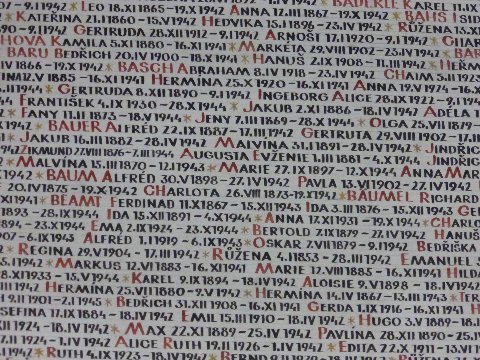
Above: Some of handwritten names of 77,297 Czech Jews sent to the gas chambers at Auschwitz and other camps on wall of Pinkas Synagogue, Prague, Czech Republic. 05 May 2016.
Czech Jews were especially hard hit by the Holocaust. More than 155,000 of them passed through the nearby Terezin camp alone. Most died with no grave marker, but they are remembered here on the walls of Pinkas Synagogue.
Jews first came to the Czech area of central Europe in the 11th century. Pre WWII there were 150K Jews resident in Czechoslavakia, most in Prague. Today there are 3000 "registered" Jews in the Czech Republic, 1800 of which live in Prague.
The several historic synagogues of the Jewish Quarter are maintained financially by contributions from US Jewish organizations, Israel, and the Czech government. The several synagogues in the Prague Jewish Quarter are among the most ancient structures in the city. The Old-New Synagogue dates to 1270.
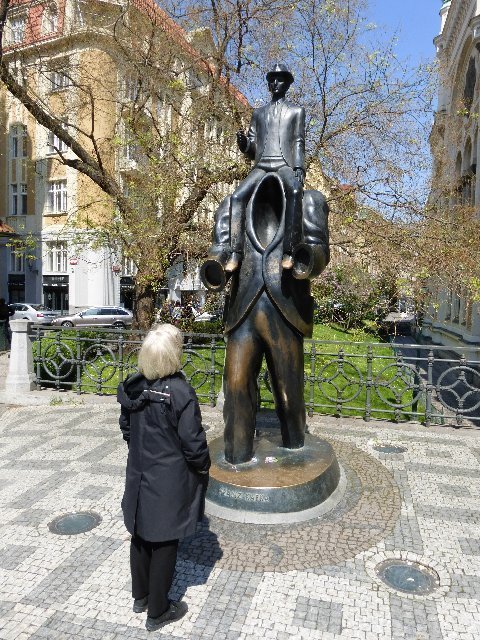
Above: TIMDT observes impressionistic (apropos of Kafka's fantastic writing style) statue of Franz Kafka. Jewish Quarter, Prague, Czech Republic. 05 May 2016.
Franz Kafka[a] (3 July 1883 – 3 June 1924) was a German-language writer of novels and short stories who is widely regarded as one of the major figures of 20th-century literature. His work, which fuses elements of realism and the fantastic,[3] typically features isolated protagonists faced by bizarre or surrealistic predicaments and incomprehensible social-bureaucratic powers,[4] and has been interpreted as exploring themes of alienation, existential anxiety, guilt, and absurdity.[5] His best known works include "Die Verwandlung" ("The Metamorphosis"), Der Process (The Trial), and Das Schloss (The Castle). The term Kafkaesque has entered the English language to describe situations like those in his writing.[6]
Kafka was born into a middle-class, German-speaking Jewish family in Prague, the capital of the Kingdom of Bohemia, then part of the Austro-Hungarian Empire. He trained as a lawyer, and after completing his legal education he was employed with an insurance company, forcing him to relegate writing to his spare time. Over the course of his life, Kafka wrote hundreds of letters to family and close friends, including his father, with whom he had a strained and formal relationship. He died in 1924 at the age of 40 from tuberculosis.
Few of Kafka's works were published during his lifetime: the story collections Betrachtung (Contemplation) and Ein Landarzt (A Country Doctor), and individual stories (such as "Die Verwandlung") were published in literary magazines but received little public attention. Kafka's unfinished works, including his novels Der Process, Das Schloss and Amerika(also known as Der Verschollene, The Man Who Disappeared), were ordered by Kafka to be destroyed by his friend Max Brod, who nonetheless ignored his friend's direction and published them after Kafka's death. Wikipedia
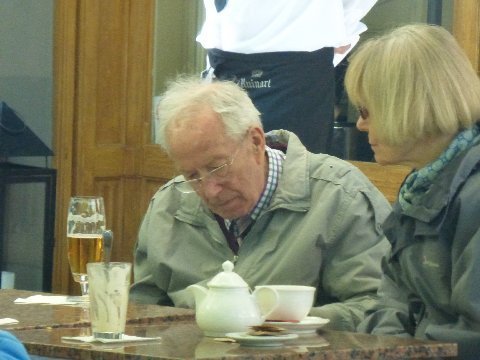
Above: Bernie Sanders takes coffee at a Prague sidewalk café. Prague, Czech Republic. 05 May 2016.
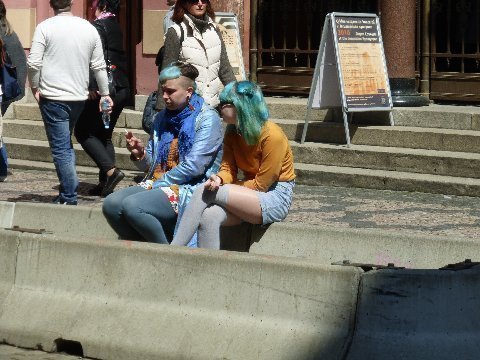
Above: Czech millennial girls enjoy a smoke outside Jerusalem Synagogue in The New Town. Prague, Czech Republic. 05 May 2016.
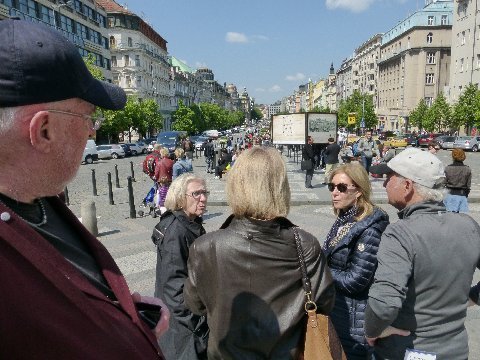
Above: Our group with guide Slavska, Wenceslas Square, Prague, Czech Republic. 05 May 2016.
Bishop, looking out "upon the Feast of Stephen."
Wenceslaus I (Czech: Václav [ˈvaːtslaf] ( listen); c. 907 – September 28, 935), Wenceslas I, or Vaclav the Good[1] was the duke (kníže) of Bohemia from 921 until his assassination in 935, in a plot by his brother, Boleslav the Cruel.
His martyrdom, and the popularity of several biographies, quickly gave rise to a reputation for heroic goodness, resulting in his being elevated to sainthood, posthumously declared king, and seen as the patron saint of the Czech state. He is the subject of "Good King Wenceslas", a Saint Stephen's Day carol. Wikipedia
Addendum:
Thought you might enjoy couple pictures for my part of the state. Also I'm curious if you have ridden the road to Los Alamos national Lab. The roads very nice and Los Alamos is beautiful. It would extend the ride to Cortez maybe 100 miles from Albuquerque. I'm planning to ride with you from Albuquerque back to Park City June 1
ITYW,
San Angelo, TX



Looking forward to riding together!
As I was exercising on my bike in the gym, I saw an interesting show. On Bikers, and the town of Sturgis and the food scene there. Have you ever go one to that rally?
Bridge,
Palm Beach, FL
Went there once... for purposes of sociological study, 18 years ago.
....couldn't agree more with Hoops and Dr. Bill. Trophies should be earned fair and square by being a winner or a runner-up and not just given out to the young for merely participating or showing up. Life in the real world doesn't work like that!
As a former selector for ELGA, I found that the worst thing was the "pushy parent syndrome" - mums or dads popping out from behind a tree to tell me how wonderful at golf their daughters were! Those poor girls' handicaps were, very sadly, their parents.
Eton Mum
Altausee, Austria
How can trophies be awarded when there is no score and and no one keeps track of wins and losses? This is why the kids got participation trophies. I would have concerns if they got participation trophies in a league that kept track of wins and losses.
Rudy Jr.
Salt Lake City, UT
Keep score?
When coaching pre-high school kids, over 16 years, in baseball and basketball, there was no question to me that the child's best interests were served by banning all parents from games.
I spent much baseball time with Frank Bartolotta, a baseball savant, former instructor with the Yankees, WWII vet, who helped some 400-500 kids get baseball or softball scholarships to college.
He had a procedure at his winter indoor baseball clinics which I first saw at his clinic for 7 and 8 year olds. Fathers would show up with their gloves, very enthusiastically ready to get involved and help out Frank with their own baseball experiences. Frank was very gracious to the fathers and would direct them over to an area so that they could meet the other fathers as Frank prepared for the clinic.
When ready, he directed Kenny, in his gravelly three-pack-a-day voice -- "close it up." The fathers were all in a chain link-fenced protective area, really an 8 by 8 cage, and Kenny would then close and lock the door
to the cage.
Frank would then commence his intense, very instructive, precise, kids-in-action clinic. The fathers were somewhat forlorn looking as they stood in the locked cage still holding their gloves. They were now passively watching a remarkable instruction for their kids and accepted their status. I was fortunate to be one of Frank's assistants, I followed his instructions and his directions and learned, so I was outside the cage.
Hoops
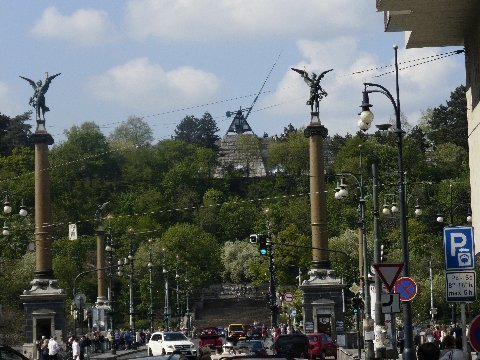
Above: Metronome sculpture. Prague, Czech Republic. 06 May 2016.
Across Checkov Bridge from near our hotel, Intercontinental Hotel Prague.
The Metronome is a giant, functional metronome in Letná Park, overlooking the Vltava River and the city center of Prague. It was erected in 1991, on the plinth left vacant by the destruction in 1962 of an enormous monument to former Soviet leader Joseph Stalin. The 75-foot-tall (23 m) Metronome is now mostly a scenic vista and a meeting place for young people. It was designed by international artist Vratislav Novak.[1]
The area behind the metronome is also a popular skate spot where skateboarders from Europe and around the world congregate and film throughout the year. Wikipedia
The metronome reminded me of my periodic coaching drum sessions with Buddy Rich, where we use an electronic metronome regularly.
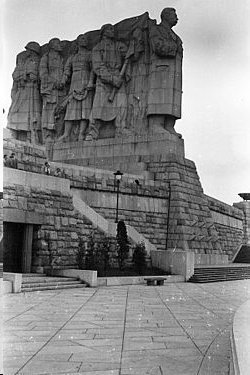
Above: Stalin sculpture extant until 1962 in location where metronome sculpture is located today.
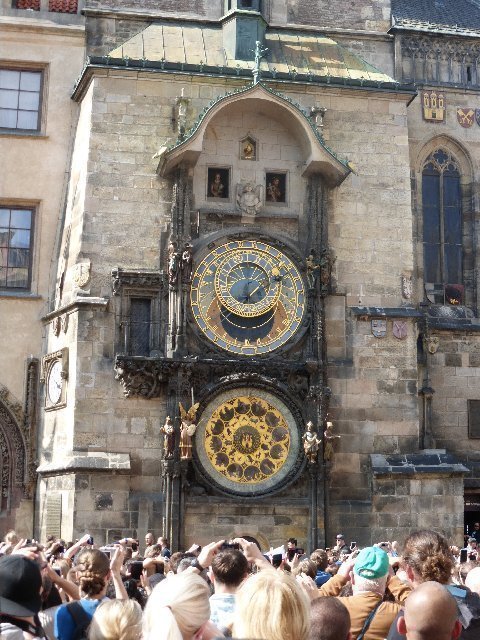
Above: Astronomical Clock. Old Town Square. Prague, Czech Republic. 4 PM. 05 May 2016.
The Prague astronomical clock, or Prague orloj (Czech: Pražský orloj [praʃskiː orloj]), is a medieval astronomical clock located in Prague, the capital of the Czech Republic.
The clock was first installed in 1410, making it the third-oldest astronomical clock in the world and the oldest one still operating. Wikipedia.
Popular Prague attraction. Square was full when I was there today. 12 apostles parade by the two windows at the top of the clock on the hour. At the end of the chime, the gold rooster above the windows flaps its wings. The skeleton to the right of the upper dial yanks a chain.
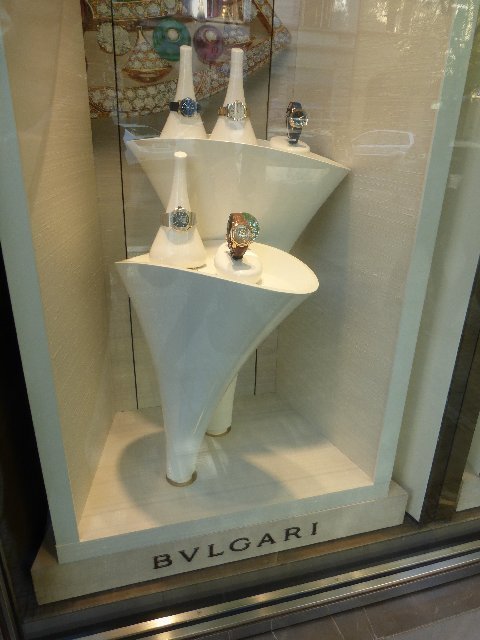
Above: Watch exhibit at Bulgari store on Paris Avenue. Prague, Czech Republic. 05 May 2016.
Paris Avenue is kind of the Rodeo Drive of Prague. Lots of uppity stores. The street links our hotel to The Old Town Square.
I captured this image for two reasons.
One. I was amazed at the price of the watch most prominent in the image. Circa $50K.
Two. At breakfast at the Murano hotel a few years ago, I sat next to (not with) Bulgari ( Sotirios Bulgarios, born in Greece of Bulgarian parents). He was extremely rude to the wait staff. He is also the owner of the largest collection of Buicks in the world.
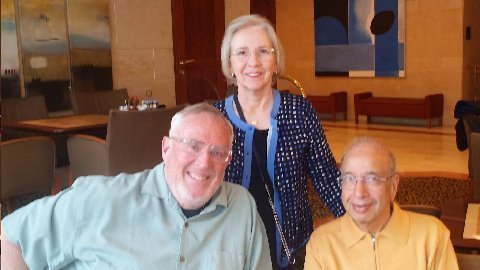
Above: Steve Taylor, Margaret Taylor, V.J. Khanna. Intercontinental Hotel, Prague, Czech Republic. 05 May 2016.
Prague is the first stop for Margaret and me on a Danube river boat tour which starts in Nuremburg, day after tomorrow, and ends in Vienna ten or so days later. During our brief Prague stay, It seemed like a good idea for us to reconnect with V. J. Khanna, full time Prague resident and former Citibanker.
Via the Park Citi list and Facebook, V.J. and I have been able to stay in touch. It was great to meet up with him and listen to his fascinating banking career story after all these forty three years of never having seen one another face to face, since our working days in Citi Calcutta, 1973.
I asked V.J. to review his career for the benefit of Park Citi list members.
Note: Note taker is fallible. Mistakes are his. V.J. is welcome to make any corrections/clarifications to these notes.
V. J., with a Masters Degree he earned in Bombay, joined Citi in 1969 and was assigned to Calcutta Branches. In Calcutta he worked, in succession for Calcutta senor branch operations officers (SBO), Mike Callen, Paul Darnal, David Ansell, and me, very briefly (in 1973). V.J. spoke highly of Bruce Brenn, who was Calcutta Branch head, my boss, when I arrived in Calcutta, 1973.
V. J. moved to Citi Delhi in 1973 where he became a trader. 1974... Bombay trader.
From 1977 to 1985 he was SBO, successively, in Madras, Delhi, Calcutta and Bombay.
In 1985 he moved to Thailand where he worked with Tatsuo Kabota at the newly Citi acquired Mercantile Bank.
He moved back to India (Bombay) in 1987, where, working for David Leong, he had a regional Treasury/risk management position.
In 1990 Victor Brunst (Citi's man in Moscow) brought V. J. to Yugoslavia where, where he worked in successive positions in Vienna, Belgrade, and Prague to advance Citi's presence in Central Europe. Carl Svoboda came to Central Europe and became a mentor to V.J. during this period. David Ansell rejoined Citi, after living semi retired in Kenya, and was part of Svoboda's Central European effort.
V. J. left Citi in 1995 and moved to Munich where he took the position of Emerging Markets head with Bayerische Vereinsbank.
In 1996, Carl Svoboda, not longer with Citi, enticed V.J. to move to Saudi where he joined Carl at United Saudi Bank, owned by Prince Wahleed, Citi's largest shareholder. Mike Callen was CEO of Saudi's National Commercial Bank during this period.
V. J. moved to Prague in 1999 where he set up a banking consulting business. He worked on a number of banking projects in the Gulf until 2008, including once, working on a project in the Gulf for Kantic Das Gupta.
In 2003, he married, second marriage, Eva Moravova, a bank executive in Prague.
In 2008, he joined Raiffeisun Bank in Prague as Treasurer.
In 2012 he retired from banking. He and Eva have a home 20 kilometers from downtown Prague and a Prague pied a terre.
V. J. notes he is enjoying retirement. He walks his dog, gardens, manages his investments, and once ever year or two visits his two boys, by a first marriage, who live in the United States. His Bay Area son works for Google and his New York City based boy owns his own software company. V. J. has four grandchildren, two by each of his two sons.
PS. We reminisced about other members of the Indian Citi diaspora... Surinder Singh in Seattle, Chita Gauba, in Vancouver/Oman, Kantic Das Gupta, Dubai, Rana Talwar, Delhi/London, B. M. Rugwani, New York City... and many others. V. J. informed me of Dave Ahuja's passing some three years ago. Both of us also had fond memories of Ajit (deceased) and Royina Grewal and Mehli and Saker Mistri who were our supervisors in the Citi Delhi branch. Margaret and I saw the Mistris and Royina at Rana Talwar's Delhi home earlier this year. Also at Rana's were Chita and Mandira Gauba, Jerry Rao, and Mike and Vickie Callen.
V.J. Sood, S.K. Jain, Manob Chakravarti and Nirendu Dutt Mazumdar are other names I knew well from that period. Also, Victor Menezies joined Citi in India while I was in Calcutta in 1973/74. A lot of important names left out here... .... and I'm the wrong one to chronicle a great era of Citibank, India.
I hope this note jogs some memories, images (photos) and some anecdotes!
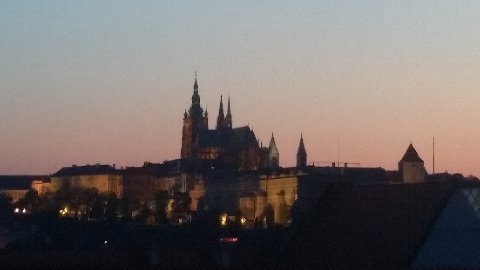
Above: Prague Castle, St. Vitus Cathedral. 9:00 PM. Prague, Czech Republic. 05 May 2016 Image taken from roof restaurant, Prague Intercontinental Hotel.
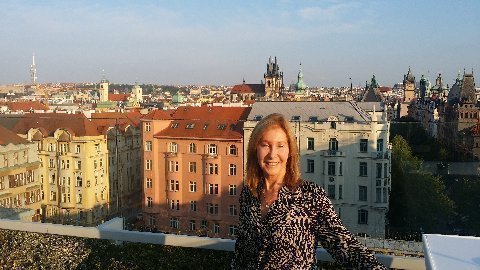
Above: Spago. Prague, Czech Republic. 05 May 2016.
Image looks over Prague from roof of Intercontinental Hotel.
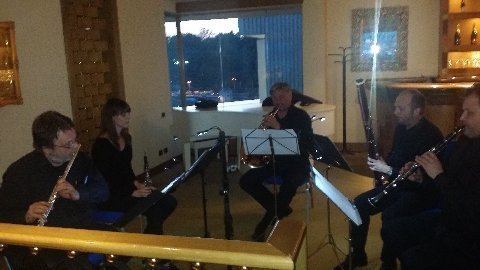
Above: Woodwind Quintet. Tauck Tours welcome dinner. Intercontinental Hotel, Prague, Czech Republic. 05 May 2016.
Addendum:
Very true it was a terrible place for Jew's also in the Budapest area - if you're in that area be sure to visit the synagogues and also the ghetto area / Tony Curtis father started the tree of life in Budapest -Enjoy
Mr. Z3,
Ojai, CA
Bernie Sanders's "coffee" looks remarkably like a beer.
Best regards,
FeeNix,
Phoenix, AZ
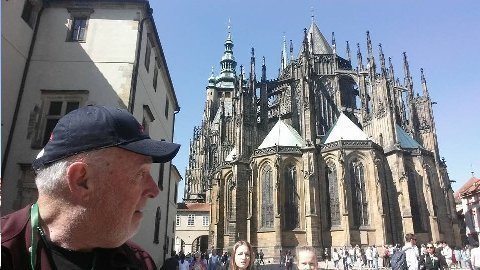
Above: The Bishop eyes St. Vitus Cathedral. Prague, Czech Republic. 07 May 2016.
Every bit Chartres or Notre Dame.
Maintenance? Little or no state assistance. Catholic Church in Czech Republic doing very well, thank-you very much. Post Communism, 1989, Church received back considerable land holdings confiscated by the Communists.
Adherents? That's another matter as some 60% of Czechs profess to be atheists, the highest percentage of non believers of any country in Europe.
Czech indifference to religion has come up in several of our tours. Many of our group assumed that the influence of the communists must have affected Czechs' attitude towards organized religion.
According to the guides, Czech religious apathy pre-dates communism. Since the xxxx's Czechs have been subjugated to outside rule.... Hapsburgs and Nazis before the Communists. Being forced to pay heed to the varying ideologies of their rulers, without having the chance to forge their own national identity, likely contributed to a cynical indifference to religion generally.
The Armenians are a former Soviet Republic and church activity there is over 90%. Church activity is growing in Russia notwithstanding 80 years of Communist rule.
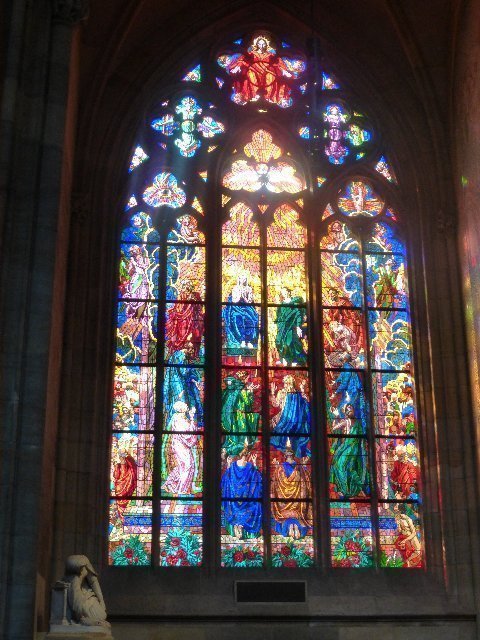
Above: Stained glass window. St. Vitus Cathedral. Prague, Czech Republic. 07 May 2016.
Zoom into the lower right panel. There is a man holding a pretzel. The individual who funded the creation of this window had a thriving bakery business.
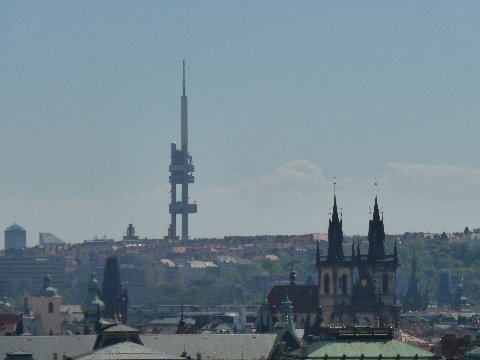
Above: Zizkov Television Tower. Prague, Czech Republic. 07 May 2016.
The tower was completed in 1989. There is a restaurant in one of the tower.
Addendum:

Steve,
Thought you might appreciate this 70% sized Honda Monkey Bike and all-titanium violin seen recently.
Malc
Tokyo, Japan
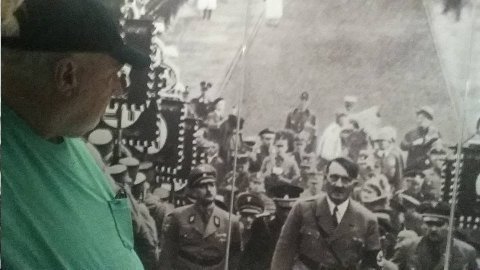
Above: Bishop observes image of Adolf Hitler. Documentation Center. Nazi Party Rally Grounds. Nuremberg, Germany. 08 May 2016.
Bishop remembers having posed in a similar image by a bust of Josef Stalin in Stalin Museum, Stalin birthplace, Gori, Georgia, a couple of years ago.
The two dictators.... Stalin and Hitler... were responsible for upwards of fifty million deaths.
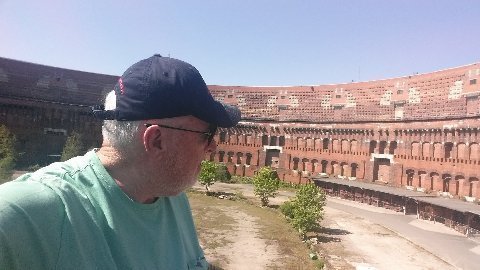
Above: The Bishop surveys Congress Hall. Nazi Party Rally Grounds. Nuremburg, Germany. 08 May 2016.
Congress Hall is one of the largest Nazi buildings to survive the war. One of the intended effects of the style used was to give the impression that the "Third Reich" was to be a momentous period in world history.
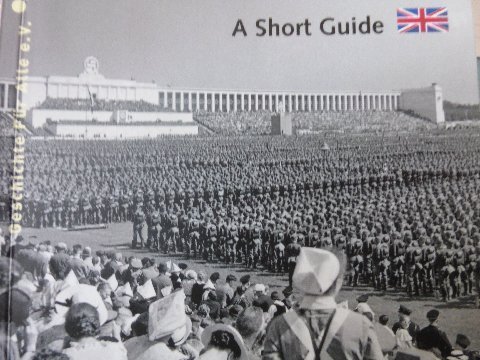
Above: Image of one of the Nazi Party rallies held in Nuremberg between 1933 and 1938. Venue: Zeppelin Field, Nazi Party Rally Grounds, Nuremberg, Germany.
The rallies, held in September, were usually attended by more than a million people. Adolf Hitler presented opening remarks and a closing speech at these rallies.
More than any other German city, Nuremberg was linked to National Socialism. The "Nuremberg Laws" from 1935 and Julius Streicher's anti-Semitic newspaper, "The Stormtrooper" promoted Nuremberg's reputation as a Nazi city.
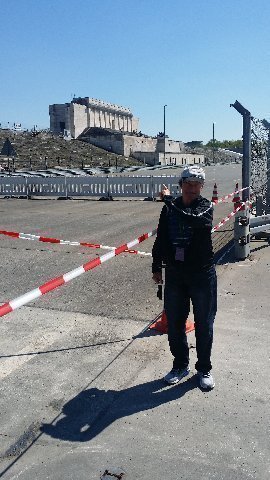
Above: Montage stands at Zeppelin Field, site of Nazi Party rallies held in Nuremberg, Germany each September from 1933 to 1938.
"Rallies" at this spot in more recent times have included The Rolling Stones, Foo Fighters, and Metallica.
The worm turns.
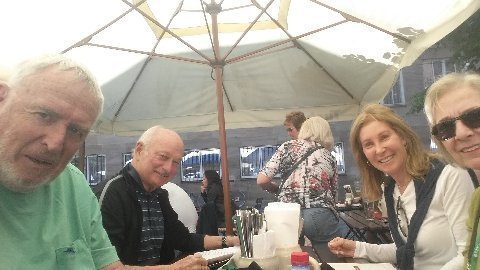
Above: Brats at Bratwurst-Roeslein restaurant. Nuremberg, Germany. 08 May 2016.
Addendum:
We loved Prague. Great beer...Pilsner Urquell
We stayed in a lovely hotel, former monastery that
Had an on going brewery from 1300s.
Bronx Girl,
Pelham, NY
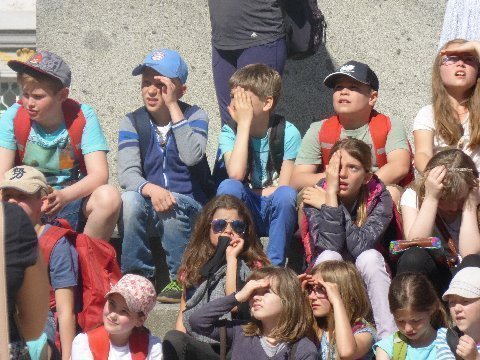
Above: German school kids. Outside St. Stephen's Cathedral. Passau, Germany. 09 May 2016.
German kids! What a surprise.
A study published by the BBC on 29 May 2015 noted that Germany had surpassed Japan for having the lowest birthrates in the world: 8.2 children per 1000 inhabitants, or, less than 1.3 births per fertile female. Japan is 8.4 and 1.4 respectively. To replace population requires a birthrate of 2.1 children per fertile female.
With its overall population aging, Germany faces two problems: First there will be few workers down the road to support its social welfare systems, on which future retirees expect to depend. Second... slowing population growth, all things being equal, will lead to labor market shortages, where the cost of labor will rise rapidly and damage the German economy and its competitiveness in the world market place.
So... Angela Merkel's 2015 initiative to invite into Germany over a million middle eastern refugees, while couched in the language of charity and generosity, is in fact rooted in economic necessity. With no labor force coming through the German birth pipeline, the difference needs to be made up with immigrants.
The issue then, becomes: "culture." Can the German culture assimilate all of the immigrants so as to absorb the German cultural ethic, or will immigrants set up their own cultural enclaves, remaining first and foremost Middle Eastern, and not German?
This latter... ie. inviting in immigrants who do not adopt local cultural norms, practices and traits, results in multiculturalism, tantamount to a slow relinquishment of sovereignty if and when the "new" culture, its laws, mores and practices, become predominant.
Angela Merkel, to quell rising citizen resistance to massive immigration from the middle east, has proclaimed that immigrants will be expected to learn German and abide by German laws an customs. Ie. "German only!" "German only?!!!!" How xenophobic of her!
Whether Germany can keep "cultural problems" arising from growing immigration under control remains to be seen. Throughout Europe, middle eastern immigrants living in their own cultural enclaves is more the norm rather than the exception. Voire... in Brussels or XXX arrondisement in Marseilles.
Need for economic growth via immigration to grow the work force is a central issue throughout Europe, not just Germany, today. Will European countries be able to keep their economies growing with the help of immigrants, without experiencing cultural clash that derails the train?
Note: US birth rate is about 1.9... higher than Germany, but still below replacement. The US continues to grow its population via immigration. The US has a better (and longer) track record of assimilating immigrants than does Europe. Necessity is the mother of invention. Perhaps Europe will have success emulating the US immigration model. Japan has never invited immigrants into its country. Without radical increases in productivity... and who's to say this can't be achieved... Japan is not far from entering secular economic decline as its population shrinks.
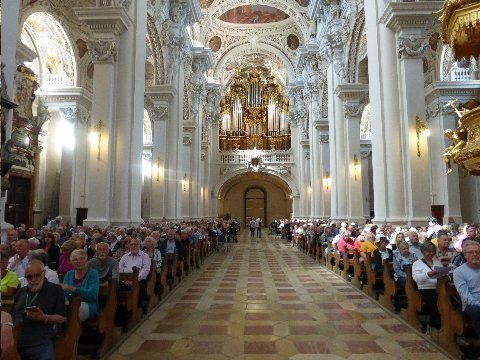
Above: Organ. St. Stephen's Cathedral. Passau, Germany. 09 May 2016.
With 17,974 pipes and 233 registers (stops) the organ is the world's largest cathedral organ. All five parts of the organ can be played from the main console.
There are larger organs... but, all are outside of cathedrals.
The pipe organ in the LDS Conference Center in Salt Lake City is larger. Our guide, a local lady of a certain age was a cheerleader for St. Stephens, though. She said she'd been to Salt Lake City to hear the LDS Conference Center organ and that it didn't pass muster compared to the "authentic," cathedral sound of St. Stephens.
The First Congregational Church of Los Angeles, CA claims to have "the largest church pipe organ in the world."
This one sounded pretty good to me. All stops open, chords resplendent.... I tear up. The reverberations after the organist takes his hands off the keys are breathtaking in the 300 year old church.
My favorite of the four numbers played today was a suite, Aus Livre d'Orgue by Pierre du Mage (1676-1751). In the final of four movements, "Grand Jeu": Huge major cords... huge reverberations. Tears. We're talking high church, here, folks.
From the Third Reich, yesterday in Nuremburg, to Renaissance Catholicism today in Passau. For me, of course, the two should not be conflated. But, both movements certainly understood imagery... the Nazis with their huge parade grounds, massive architecture and ceremonial pomp... and the Catholics with their magnificent cathedrals and organ music.
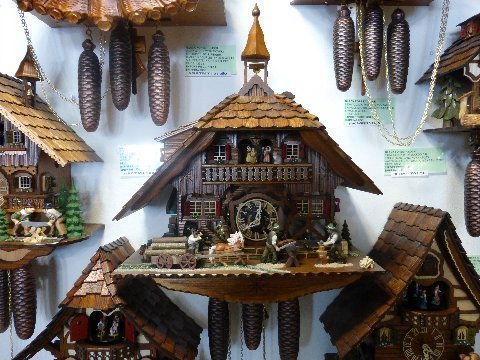
Above: Cuckoo-clock. Heidi and Peter's Ladl. Domplatz, Passau, Germany. 09 May 2016.
There are a half dozen riverboats at the Passau dock. One gets the impression that the local stores, restaurants and coffee houses are doing a good business from the tourists. Locals I see, perhaps not directly involved in the tourist trade, seem... well, "resigned." Passau seems little different from other cruise ports... Skagway, Caymans...Greek Islands.... wherever there is a cruise boat. Havana, next.
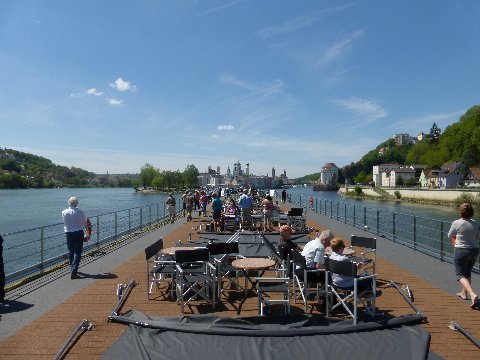
Above: Conjunction of three rivers at Passau: Left, Inn; center, Danube, and right, Ilz. Passau, Germany. 09 May 2016.
Image looks astern from Tauck Savor river boat sun deck, to city of Passau, upstream towards the three river confluence. St. Stephen's Cathedral, a baroque church, is the largest edifice in the distance.
The river continues as the Danube, passing through Austria, Hungary and Romania before reaching the Black Sea at Constanta.
TIMDT and Mwah (sic) were in Constanta, Romania's Black Sea port, about two years ago.
The Danube is navigable from the Black Sea all the way (with the help of a couple of canals, to Amsterdam, Holland, a distance of 2000 miles.
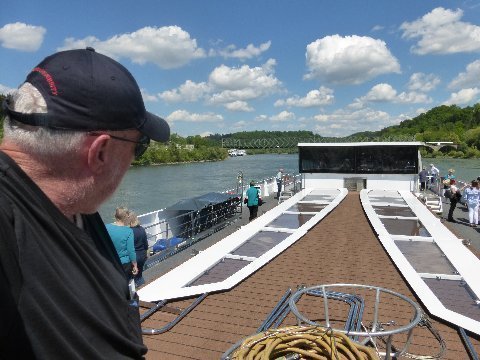
Above: The Bishop aboard the Tauck Savor. 09 May 2016.
Image looks over the bow, upstream of Passau, Germany, now receding into the distance.
Spectacular weather for river cruising. 72 degrees and mostly sunny.
My first observation about the difference between river cruising and ocean cruising is that the river boat captain has to be navigating/steering the riverboat constantly. The river meanders and there are locks along the way. The sea captain, charts a course and puts the ship on auto pilot. Of course crew are looking at radar watching for obstacles in the water notwithstanding the ship's "piloting itself."
After leaving Passau, Germany, the Danube entered Austria. TIMDT observed that cruising down the river reminded her of cruising the Norway fjords. As we sit in our port side cabin, we look full length and height windows at the passing Austrian country side.
I see people seated along the banks of the river. Sometimes, when we cruise by a town, there is a park along the river bank. I am reminded of the times when Sabey and Mwah (sic), LDS missionaries assigned in 1967 to Nogent sur Marne, in the eastern Paris banlieu, would have lunch seated in the grass alongside the Marne, watching the river traffic. A typical lunch was a baguette and some gruyere cheese, washed down by a concoction then called "limonade," but more like tonic water.
Addendum:
Hi Steve,
Sounds like a great trip. We visited Jane and Bill .... (Citi Singapore) when they were living in Prague a couple of decades ago. It is a great little city which was spared the devastation of WW2. I was stationed for three years in Germany and know some of the area you will be visiting very well.
Christy and I are also off on a bucket list trip. We leave on Monday to walk the Camino de Santiago. After we spend a week in Portugal, drive through northern Spain, then a long week around Southwestern France. We finish up with a week in Ireland, half with my daughter’s family and half in Dublin. (After training in London, Dublin was my first posting with Citi so will be catching up with several retired Citibankers. Jim ...., former CCO, was my first real boss in Citi.)
Many of the folks on the Park Citi list are old friends. It is great that you have made us all connect.
Have a great cruise.
Dean, Miami, FL
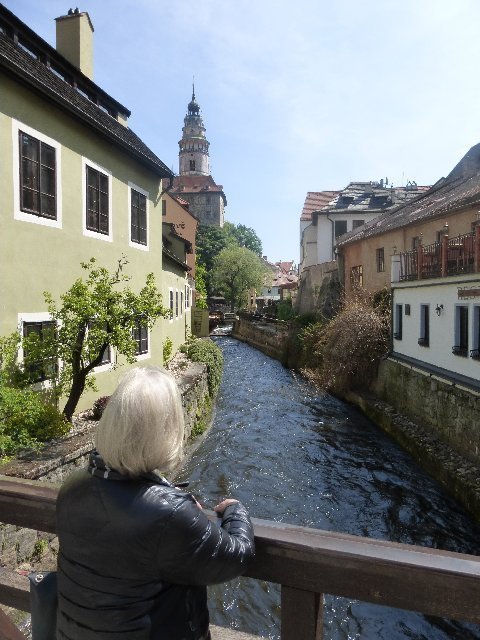
Above: TIMDT observes Chesky Krumlov Castle from bridge over Vltava River. Chesky Krumlov, Czech Republic. 10 May 2016.
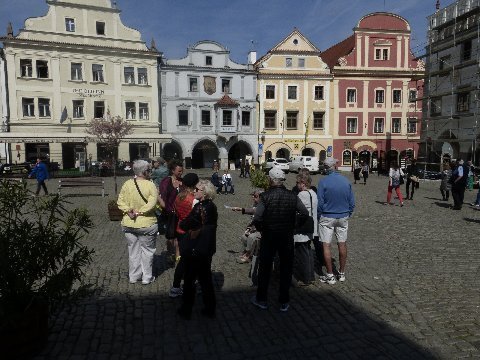
Above: Svornosti Square. Cesky Krumlov, Czech Republic. 10 May 2016.
TIMDT and other Tauck tour goers appear in image.
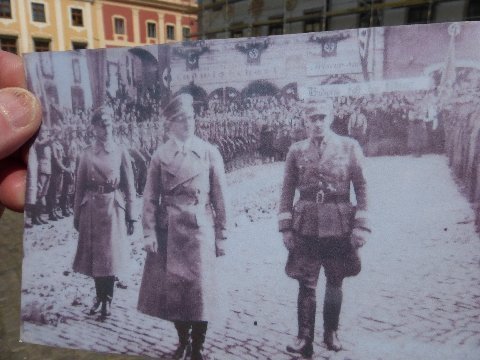
Above: Svornosti Square, Cesky Krumlov. Czech Republic. October 1938.
Adolf Hitler and German soldiers appear in the image.
Cesky Krumlov, World Heritage Site city, heretofore "off the radar," is in Czech Sudentenlands. Majority German town was visited by Hitler in Ocober of 138. Hitler liked the architecture in this beautiful city, newly part of the Third Reich (thanks to Neville Chamberlain appeasement). He said Cesky Krumlov would be a nice place but for the minority Czechs living there.
As part of the settlement post WWII, German residents of Cesky Krumlov were repatriated to Germany leaving Cesky Krumlov a ghost town. Since the 1980's, major restoration and new Czech residents attracted to run tourist businesses, has resulted in the refurbishing of one of the more beautiful castle towns of Europe.
I walked... today... where Hitler walked......
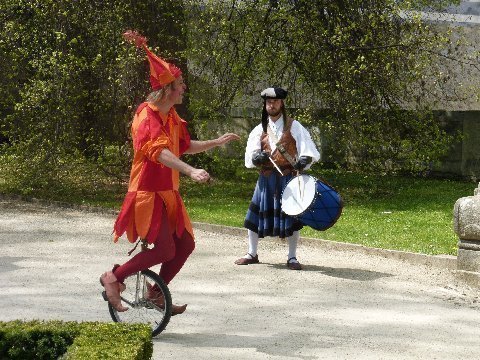
Above: Renaissance Fun for Tauck tour tour goers. Cesky Krumlov Castle gardens. Cesky Krumlov, Czech Republic. 10 May 2016.
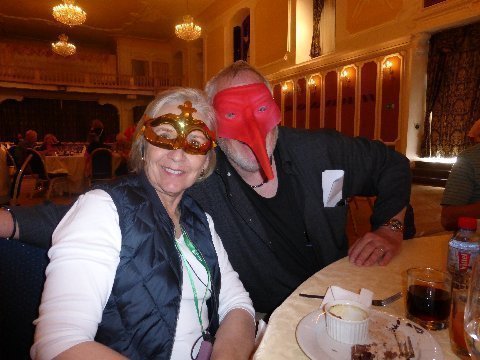
Above: TIMDT and the Bishop. Feigning Renaissance. Lunch for Tauck tour goers. Renaissance music, juggling and lots of protein. Cesky Krumlov Castle. Cesky Krumlov, Czech Republic. 10 May 2016.
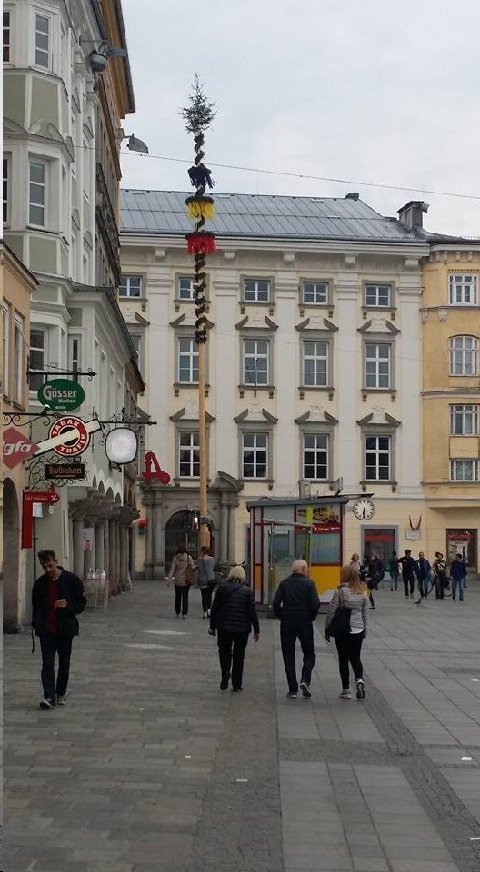
Above: TIMDT, Montage, and Spago walk towards May Pole in Hauptplaz. Linz, Austria. 10 May 2016.
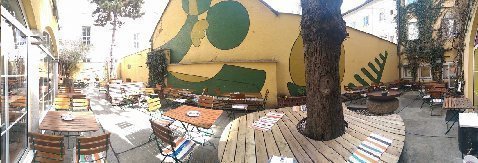
Above: Wirt am Graben Restaurant. Linz, Austria. 10 May 2016.
Montage led us here for some authentic - and excellent - Austrian dishes. Recommended.
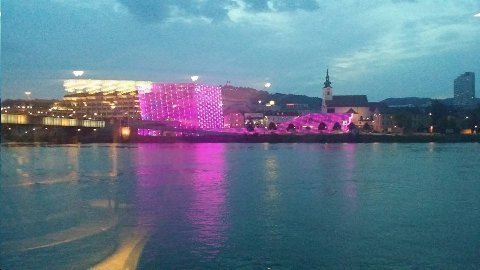
Above: Arstechnica Building. On Danube. Linz, Austria. 10 May 2016.
LED illuminated, virtual Rubic's Cube building. Image captured from lounge on Tauck Savoy river boat docked on Danube River.
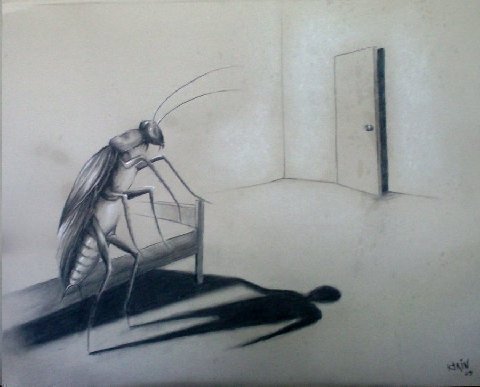
Above: "The Metamorphosis," Franz Kafka.
While in Prague I picked up a copy of Prague denizen writer Franz Kafka's novella, "Metamorphosis." I completed the book today, 10 May 2016.
30 year old traveling salesman Gregor lives with parents and younger sister when not on the road.
One morning, while at home, he wakes up in the morning in his bedroom and finds himself transformed into a grotesque insect.
Gregor's transformation is an absurdity. Nothing, Kafka tells us, is certain in this world.
Even more absurd is the reaction of Gregor's family members. They are shocked, to be sure, but, they do nothing to diagnose the problem or seek a cure for his condition.
Rather, Gregor and his family do their best to try to adapt to their new situation.
Over time... months.... Gregor's family becomes alienated to Gregor. Gregor (the insect) overhears that he is not wanted in the house any more.
As an act of self will and self disgust for his effect on his family, Gregor the insect dies. His remains are carried out by the cleaning lady.
The remaining family, thinking their lives were ruined, goes through a renewal of sorts. All end up with good jobs. On a spontaneous picnic parents note the physical maturity of their daughter (Gregor's sister) and muse about possibilities for her marriage.
Is the author's metaphor that Gregor was already living an alienated life? A live void of any humane appreciation? Were his emotions cold and his ability to communicate constrained so as to have already turned him into the equivalent of an insect?
And what about us......?
Addendum:
We loved Prague. Great beer...Pilsner Urquell
We stayed in a lovely hotel, former monastery that
Had an on going brewery from 1300s.
Bronx Girl,
Pelham, NY
Steve:
If you're still in Nuremburg, go to the Brathaus in the old city. Outstanding.
Bling,
Albuquerque, NM
America is about an idea, embodied in the Declaration of Independence. Immigrants assimilate by identifying with an idea, not a culture. In America, they can keep their culture and be Americans. European countries self identify with a national culture. Despite your admiration for German motor vehicles and a French bistro, neither country would adopt you. But we, whose forebears were among the "huddled masses, yearning to be free," consider you one of ours.
FeeNix,
Phoenix, AZ
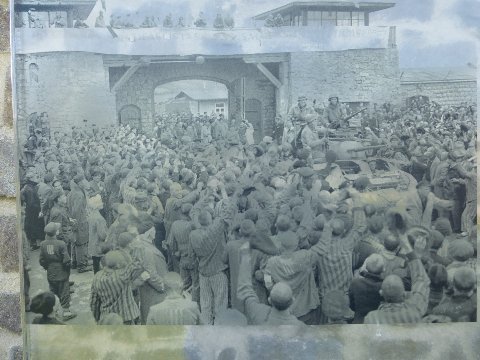
Above: American tanks enter the main gate to liberate concentration camp prisoners. Mauthausen Concentration Camp, Austria. 05 May 1945.
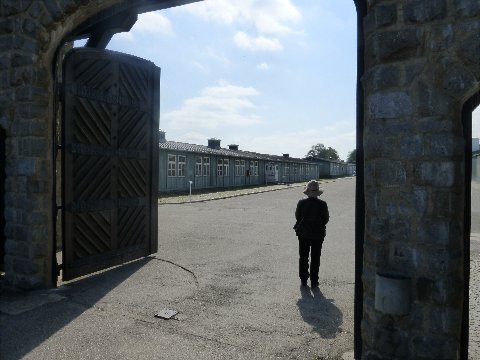
Above: TIMDT stands in the silence at the main gate. Mauthausen Concentration Camp, Austria. 11 May 2016.
1938-1939: The construction of the Concentration Camp.
* The National Socialists take over of power marked the beginning of the persecution of political opponents, marginal social groups and Jews
* Following the annexation of Austria, Mauthausen was chosen as the site for a concentration camp. The first prisoners arrived on 08 August 1938 from the concentration camp in Dachau.
* They were robbed of their names and turned into numbers. Every day life in the camp was characterized by deprivation, violence and death.
1940-1942: Internationalization and Mass Murder
* The Second Word War and the occupation of large parts of Europe by the German army influenced the further development of Mauthausen concentration camp.
* Thousands of people were deported to Mauthausen and Gusen from the occupied countries. The SS began the systematic mass murder of certain groups of prisoners.
* While some prisoners rose in the camp hierarchy, others remained isolated. Work in the quarry cost many prisoners their lives.
1943-1944: Arms Industry and Sub Camps
* In view of the increasing shortage of skilled workers, forced labour became crucially important for the German war economy.
* A network of sub-camps was established so that concentration camp inmates could be put to work in the arms industry. Mauthausen concentration camp evolved into a camp system.
* For some prisoners living conditions improved, while others who were sick or unable to work were murdered or left to die.
1945: Overcrowding, Mass Death and Liberation
* The advance of the Allied armies and resistance efforts throughout Europe put an end to the National Socialist regime.
* In the final months of the war, thousands of people were forcibly removed from concentration camps elsewhere that were being disbanded and were brought to Mauhausen.
* The prospect of liberation gave many prisoners new hope. At the same time, however, they lived in a constant state of uncertainty and fear of being killed by the SS.
Circle of Silence
Amongst the general German populace knowledge the atrocities committed by the SS at the concentration camps was wide spread. Word of mouth, letters, photographs etc. filtered back to the German citizenry from soldiers assigned to the camps.
Notwithstanding, the subject (atrocity) was never discussed amongst the people. Goebbels, at first worried that a PR campaign to paper over what was going on at the camps might be necessary, later backed off, calling the non-talk about happenings at the concentration camps a "circle of silence."
Is the political correctness seen in our time is another form of the same phenomenon - circle of silence?
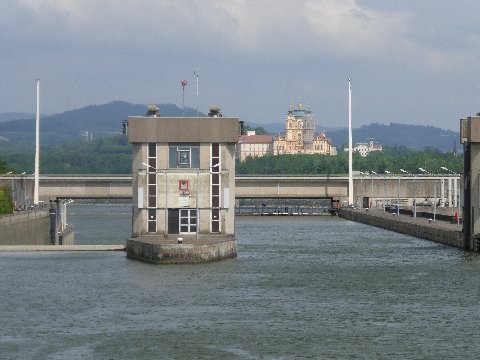
Above: Melk Abbey as seen through Melk lock on the Danube River. Melk, Austria. 11 May 2016.
Image captured from observation deck of Tauck river boat, Savor.
Melk Abbey is a Benedictine abbey above the Austrian town of Melk. It sits on a rocky outcrop overlooking the Danube River. The abbey contains the tomb of Saint Coloman of Stockerau and the remains of several members of the House of Babenberg, Austria's first ruling dynasty. The abbey was built in 1089.
The best images of the abbey, taken from the river, are from just up river from the lock. Once the ship is lowered some 30 feet in the lock to the down river level, sighting of the abbey from the river is occluded.
Melk lock is one of ten Danube locks in Austria.
The Danube is Europe's second-longest river, after the Volga River, and also the longest river in the European Union region. The river flows south from the Black Forest in Germany through, or touching the borders of, Germany, Austria, Slovakia, Hungary, Croatia, Serbia, Romania, Bulgaria, Moldova and Ukraine before emptying into the Black Sea.
When linked with the Rhine Main - Rotterdam canal, it is possible for river traffic to go from the Atlantic Ocean (Rotterdam) to the Black Sea (Constanta, Romania), a distance of 2,200 miles. TIMDT and Mwah (sic) were in Constanta two years ago while on a Black Sea/Aegean Sea cruise on Seabourn.
Down river from Melk lock is the Wachau Valley, one of the most prominent tourist destinations of Lower Austria. The valley is known for its high-quality wines and apricot digestifs. Wachau Valley, cut by the Danube River, is 25 miles long. It has been settled since prehistoric times.
The Danube formed the northern border of the Roman Empire.
Beyond, to the north? ... us barbarians.
Addendum:
I read with special interest your notes on the organ at St. Stephen's Cathedral. Of course you shed tears..the sound coming from such an instrument is powerful enough to move your spirit right up to the very edge of God's touch. Wish I could have been there, but reading your account of the experience was good enough for today.
Magnolia,
Miami, FL
How very appropriate.
Jack Aroon,
Mahwah, NJ
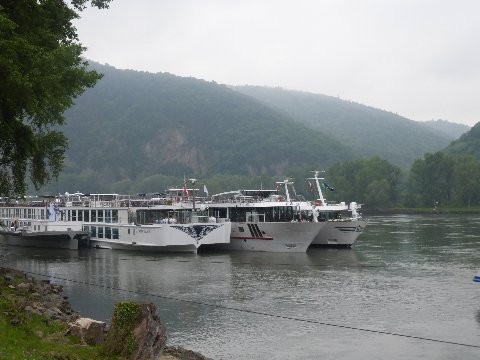
Above: Riverboats dock on the Danube at Durnstein. Durnstein, Austria, 12 May 2016.
The Tauck "Savor" is on the outside. The longest of these Danube river boats run 142 meters long. A football field and a half. The ships carry up to 125 passengers and 25 crew.
The water depth of the Danube is variable. Average depth is about 25 feet. Depth before a lock can reach 400 feet. The boats' draft is five and one half feet. Spring time navigation is "no problem" according to our captain, but, late summer water levels can make navigation more dicey though not prohibitive.
Flood events of one kind or another.... too much water from Spring runoff, or even improper dam/lock operation.... happen every five years. 2013 was the last 100 year event when water levels reached so high that all navigation was halted.
While walking through towns along the way, guides pointed out, on the sides of buildings, the high water marks of the 2013 flood.
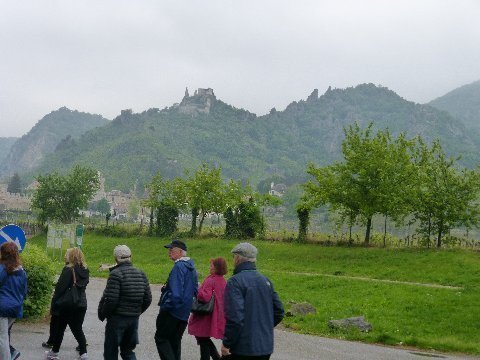
Above: Sightseers, foreground. Durnstein Castle, background. Durnstein, Austria. 12 May 2016.
A well-known place and tourist attraction along the Danube in Austria is Dürnstein, where King Richard the Lion-Heart of England was held captive (in the castle) in1192 for ransom by Austrian Duke Leopold V during his (Richard's) return from Jerusalem and the third Crusade.
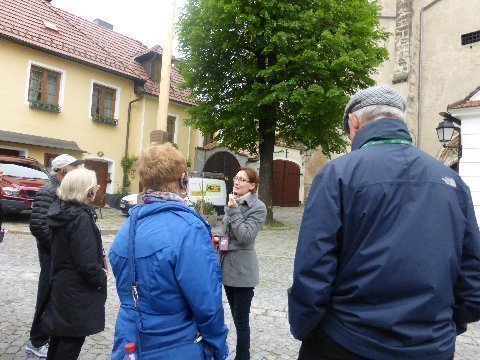
Above: Hannah, Austrian local tour guide during our visit to Durstein, Austria. 12 May 2016.
Most of our local guides throughout our Danube River riverboat tour have spoken impeccable English.
The guides speak with accents, to be sure. But, their grammar and usage is near perfect. Who makes a point of differentiating between "who" and "whom" any more? These guides do.
They use American colloquialisms comfortably. "Lets do this...."
Some of them have learned English from non native speakers. So, you can occasionally hear pronunciation quirks... one guide in Prague would say, "bee koo az" meaning "because." Notwithstanding, this particular guide spoke the language better than 95% of English speakers (in my experience).
Almost without exception, the guides knew their subjects in depth. At times I thought to myself, "these people are overqualified. What are they doing as tour guides (not to demean the avocation)?"
If the English language is preserved in the future in correct grammatical usage, it won't be by Americans, but by Europeans who speak English as a second language.
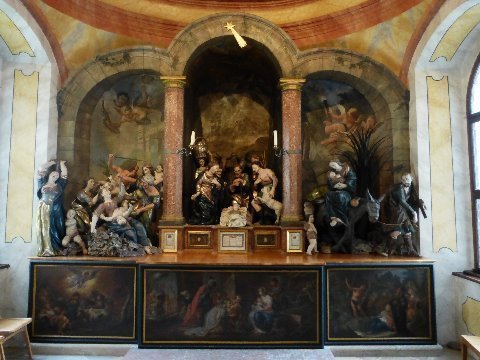
Above: Manger diorama. Cloister, Parish Church of Durnstein. Durnstein, Austria. 12 May 2016.
Tauck tour goers were invited into the Benedictine monks' cloister, not normally open to the public.
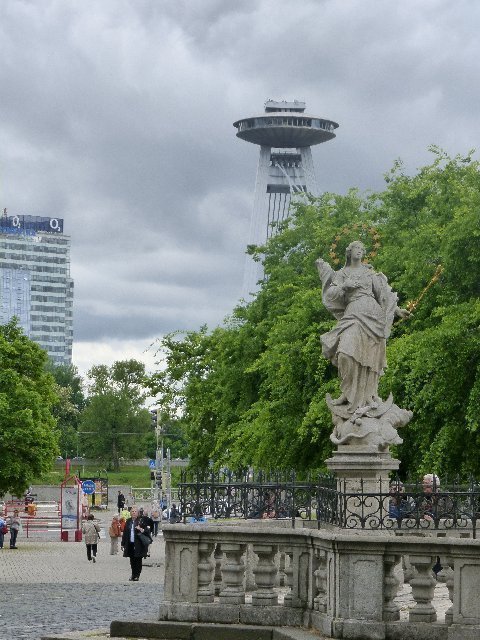
Above: TIMDT (in black facing camera to left of statue). Novy Most (bridge) in the background. Bratislava, Slovakia. 13 May 2016.
The sacred (statue) and the profane (bridge)?
Locals refer to the bridge as "UFO bridge" because of the saucer like structure atop the bridge's one pylon. The "UFO" houses a restaurant and an observation deck.
The bridge, over the Danube, was constructed in 1972 during the Communist period. It is the world's longest cable-stayed bridge to have one pylon and one cable-stayed plane. Locals refer to the bridge as the UFO Bridge after the restaurant called "UFO" in the bridge tower top.
The bridge is the one of the few features of Bratislava I remember from Rudy Jr.'s and my visit to Bratislava (as part of a driving trip through Hungary, Austria, and (then) Czechoslovakia in the mid 1980's.
Rudy Jr. and I stayed in a hostel outside of the old city. We were up all night because of a rock concert going on just outside our room window. On awakening one morning, our rental car had been broken into and driven some distance, before it was returned to a spot near where we had left it the night before.
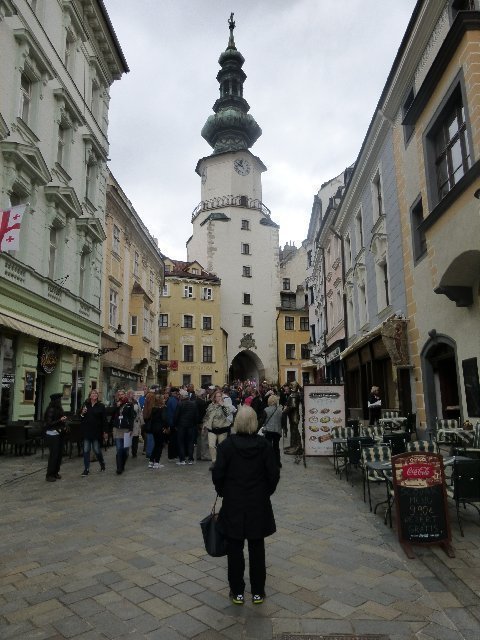
Above: TIMDT observes St. Michael's Gate. Bratislava, Slovakia. 12 May 2016.
St. Michael's gate is the last remaining of four like gates in the old city.
No cars are allowed in old town Bratislava. I wondered why Park City didn't turn its main street into a mall. Malls are happening places which attract people. it seems to me to be a no brainer for a Park City main street business to want a mall outside their door.
Bratislava is the capital of Slovakia, and with a population of 450K, the country's largest city. Bratislava is in southwestern Slovakia, occupying both banks of the Danube river and the left bank of the river Morava.
Bratislava is home to several universities, museums, theaters, galleries and other important cultural and educational institutions.
The history of the city has been strongly influenced by people of different nations and religions, namely by Austrians, Croats, Czechs, Germans, Hungarians, Jews, Serbs and Slovaks.
The city was the capital of the Kingdom of Hungary, a part of the larger Habsburg Monarch territories, from 1536 to 1783, and has been home to many Slovak, Hungarian and German historical figures.
Slovakia is "on a roll" compared with the rest of Europe. 1MM cars a year are manufactured here which makes the country have the highest per capita manufacturer of cars in the world. Unemployment is only 3%. Slovakia has a 19% flat tax with around 3% economic growth... much better than the rest of Europe.
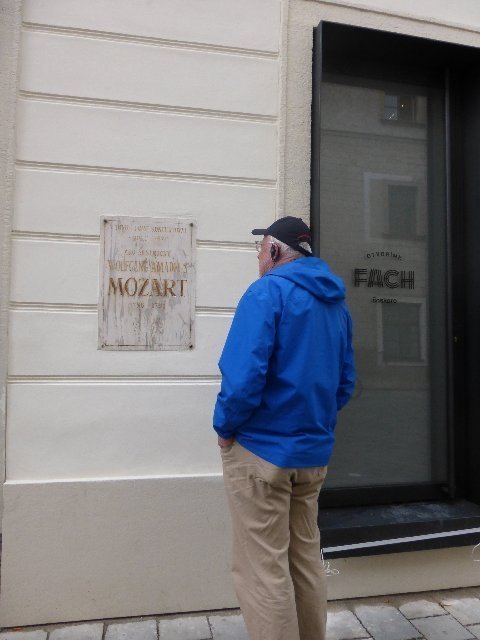
Above: The Bishop observes a plaque in Old Town, Bratislava.
Plaque purports that Mozart played a concert in this building when he was six years old.
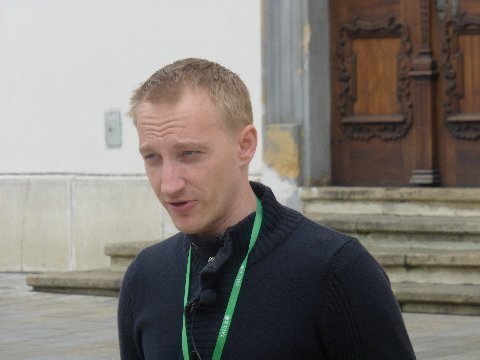
Above: Local Guide, Emil. Bratislava, Slovakia. 13 May 2016.
This fellow, highly English fluent like the rest of our guides, had a drole sense of humor. Some of his remarks:
Two people never to trust: A politician and a tour guide.
Here in our town square are the embassies of some of the richest countries in the world.... France, Japan and Greece.
The Jesuits... the most talented and the richest of Catholic orders.... but... ahhhh.... the Inquisition!
Describing the disputes over how many stars to put on the flag of the European Union: Ahhh.... the EU... where no one is satisfied! I love it! (The flag has 12 stars).
Describing the regular intermarrying of royalty: Incest is a game for the whole family!
Emil was quick to lambaste the Communist rule his country experienced in the aftermath of WWII through the so-called "Velvet Revolution" in 1989, when communism gave way to democracy. It was gratifying to hear Emil talk about the evils of totalitarianism, particularly when so many of America's millennials seem to want to embrace it.
Emil:
Communists love uniformity.
Under communism, no one asks you for your opinion.
Communism. Repeat a lie often enough and everyone begins to believe it.
If only American millennials could listen to this Slovak millennial, Emil. I have suggested that America's big-government-enforced-outcome-equality-seeking-millennials be offered a free, one way ticket to Havana where they can live out their chosen ideology real time. To compensate, the US would open the H1B floodgates to qualified people with a work ethic. Only then would my social security payment be guaranteed (cough).
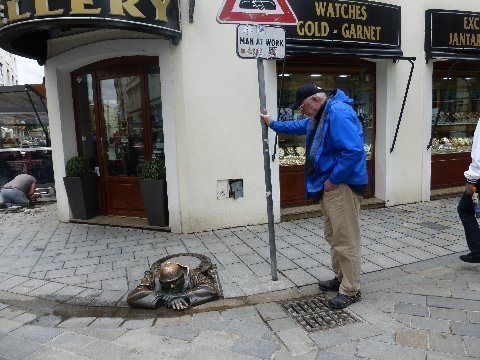
Above: "Cumil". Sculpture of Viktor Hulik. Old Town. Bratislava, Slovakia. 13 May 2016.
Cumil (the peeper) is either resting after cleaning the sewer or is looking under women's skirts.
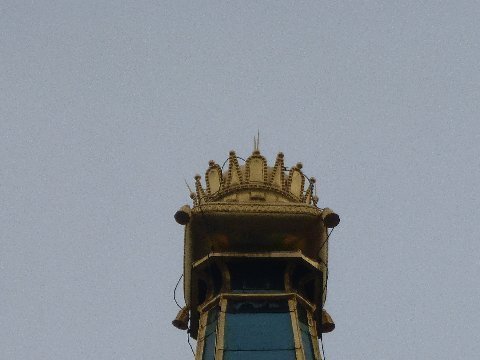
Above: Replica of Hungarian royal crown atop St. Martin's Church. Bratislava, Slovakia. 13 May 2016.
St. Martin's Church, a 14th century gothic construction, is known most for being the coronation church for the Kingdom of Hungary between 1563 and 1830.
Maria Theresa of Austria was crowned at this church in June 1741.
The crown at the tower top is a gold-plated replica of the Crown of St. Stephen. It was placed in 1847 following restoration of the damaged tower, to commemorate the cathedral's importance as a coronation church. It weighs 350 pounds, measures 3.3 feet in diameter, and rests on a four foot by four foot gold-plated pillow. The pillow and the crown contain a total of 18 pounds of gold and were restored in August 2010.
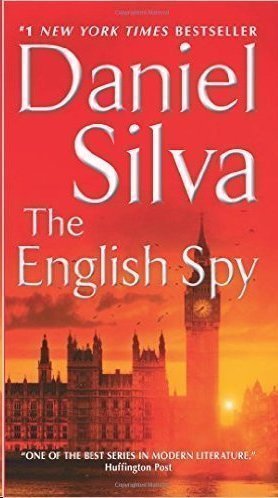
Above: Book Cover. "The English Spy" by Daniel Silva. 13 May 2016. Bratislava, Slovakia.
I completed this book today, my umpteenth Daniel Silva novel featuring the character of Gabriel Allon, crack Israeli spy/assassin and soon to be head of Israel's spy agency.
This novel features Christopher Keller, a one time British special forces soldier, believed dead, but now a paid assassin in the hire of a Corsican olive grower.
Keller and Allon follow the track of a former IRA "big" who has been contracted by the Russian president to kill them as they were the agents (in a former novel, "The English Girl,") who disrupted the Russian scheme to get control of North Sea oil.
As with Lee Child's novels featuring Jack Reacher, the plots fade over time but the characters remain vivid. Gabriel Allon is a walker. He has a place on The Lizard, in Cornwall, where, if he had his druthers, he would be living, spending his time as an art restorer and a frequent walker, rain or shine, along the cliffs of the Lizard . Allon has been an inspiration to me in his love for solitary, contemplative walking.
TIMDT and Mwah (sic) walked on the Lizard during a visit to Cornwall in the late 80's.
Addendum:
Nonsense.
It was plain unvarnished anti-Semitism.
Jack Aroon,
Mahwah, NJ
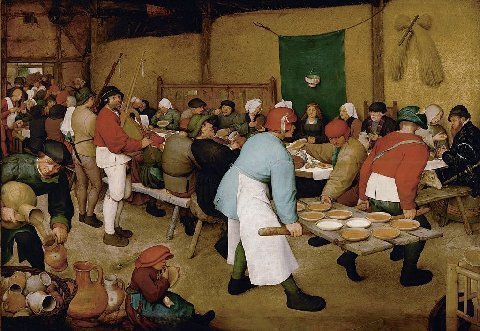
Above: "The Peasant Wedding." Pieter Bruegel the Elder. Circa 1567. Flemish School. Kunsthistorisches Museum, Vienna, Austria. 14 May 2016.
The man in the red jacket carrying the food tray. Three feet. Bruegel toying with us?
No explanations have been found for this anomaly... only speculation.
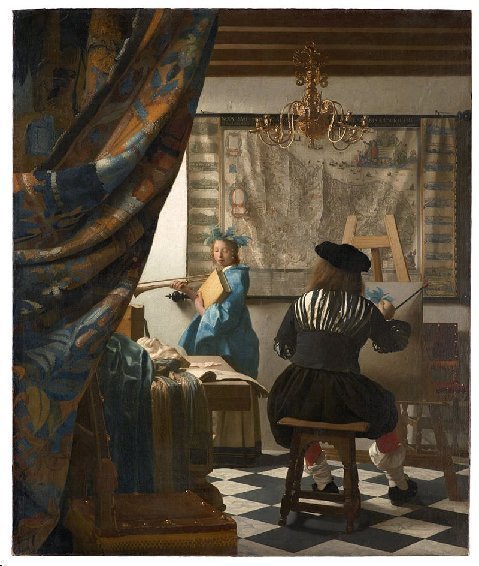
Above: "The Art of Painting." Johannes Vermeer. 17th Century. Flemish School. Kunsthistorisches Museum, Vienna, Austria. 14 May 2016.
One of Vermeer's most famous paintings.
According to Albert Blankert, art critic, "no other painting so flawlessly integrates naturalistic technique, brightly illuminated space, and a complexly integrated composition." Note the development of the indirect light on the floor and the curtains.
The painting was acquired by Hitler from the Czernin (Austria) family for 1.82 million Reichsmark on 20 November 1940.
The painting was rescued from a salt mine near Altausee at the end of World War II in 1945, where it was preserved from Allied bombing raids. The painting was escorted to Vienna from Munich, chief of the Monuments, Fine Arts and Archives program (MFA&A) for Austria, who transported it by locking himself and the painting in a train compartment (anyone see the movie, "Monuments Men")?
The Americans presented the painting to the Austrian Government in 1946, since the Czernin family were deemed to have sold it voluntarily, without undue, force from Hitler. The painting is now the property of the Austrian Republic.
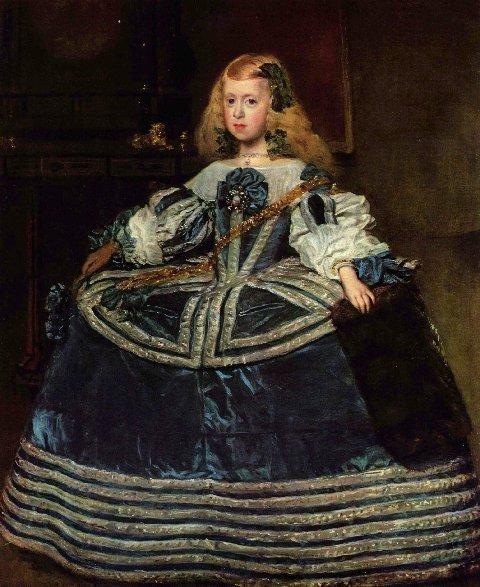
Above: "Infanta Margarita Teresa in a Blue Dress." Diego Vasquez. 1659. Kunsthistorisches Museum, Vienna, Austria. 14 May 2016.
Painting shows Margaret Theresa of Spain, age 8. The painting is part of several portraits of Margarita Theresa, in the same pose, at different stages of her life.
Margaret Theresa married her uncle, Leopold I, Holy Roman Emperor at the age of 15.
Painting is considered by many critics as best of all Diego Vasuez' work.
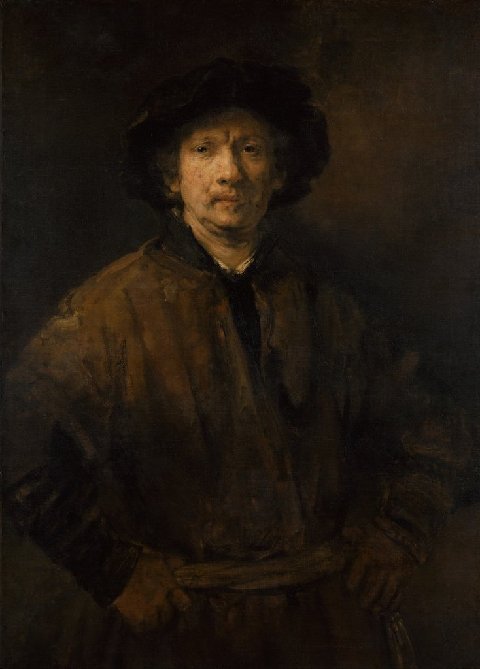
Above: "The Large Self-Portrait." Rembrandt. 1652. Kunsthistorisches Museum, Vienna, Austria. 14 May 2016.
"The Large Self-Portrait," oil on canvas, is one of at least 40 self-portraits painted by Rembrandt.
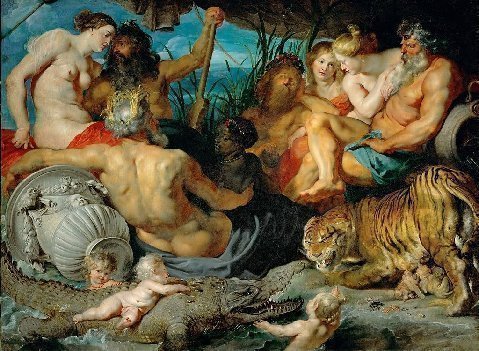
Above: "The Four Continents," also known as "The Four Rivers of Paradise." Peter Paul Rubens. Flemish School. Circa 1615. Kunsthistorisches Museum, Vienna, Austria. 14 May 2016.
The painting depicts the female personifications of the four continents (Europe, Asia, Africa and America) sitting with the personifications of their respective major rivers - the Danube, the Ganges, the Nile and the Rio de la Plata (our tour guide said Mississippi).
Europe is shown on the left, Africa in the middle, Asia on the right and America behind it, to the left. The tigress, protecting the cubs from the crocodile, is used as a symbol of Asia. The personification of the Danube holds a rudder. The bottom part of the painting shows several putti.
Painted during a period of truce between the Dutch Republic and Spain, the river allegories and their female companions in a lush, bountiful setting reflect the conditions that Rubens hoped would return to Antwerp after military hostilities.
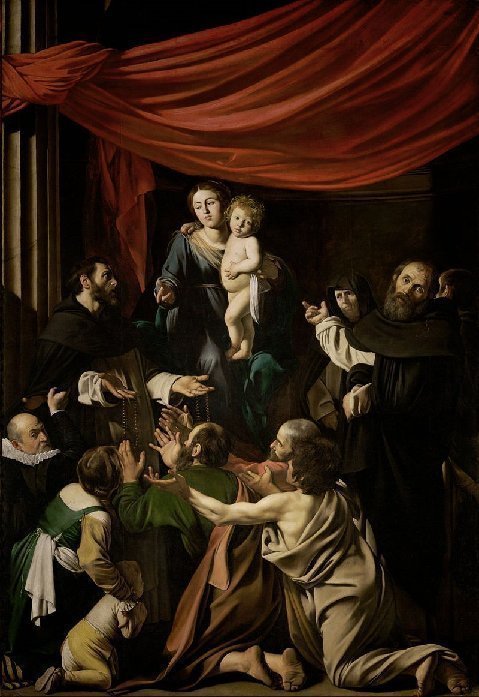
Above: "The Madonna of the Rosary." Caravaggio. 1607. Florence School. Kunsthistorisches Museum, Vienna, Austria. 14 May 2016.
Intended as an altar piece, the one who commissioned the painting thought it too unconventional. Caravaggio was an artist iconoclast of his day. This painting didn't fit the convention of the times. The Madonna looks bored and is too plain. And where is the Madonna's traditional red and blue look? She is dressed in blue only. Baby Jesus looks more like a gamin than the Christ child. And, what about all those people with the tattered, dirty clothes and dirty feet below the Madonna? This is a travesty!
Trying to find a buyer, Caravaggio reworked the painting a bit. The red drape above was added. Note the two differently colored knees in the blue robe of the Madonna, showing that finding the same color of paint is difficult. The most important alteration of the painting was painting in the painting's ultimate buyer, the Flemish dressed man in the left corner of the painting.
Caravaggio was a larger than life personality. He regularly overdosed on women, girls, boys and booze. Considering the world we live in today, there is, apparently, nothing new under the sun.
Gabriel Allon, Daniel Silva's famous character in his series of novels about the Israeli spy and classical art restorer - and friend of the Pope -, would usually be restoring a Caravaggio when he wasn't hunting down a terrorist.
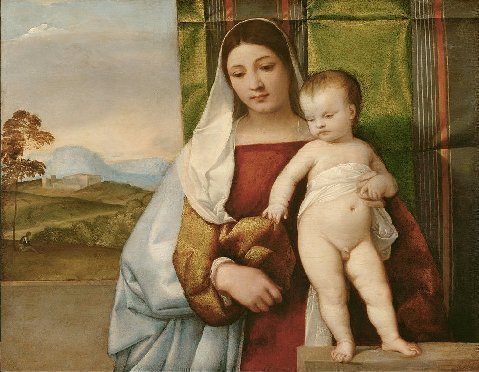
Above: "The Gypsy Madonna." Titian. Venetian School. 1510. Kunsthistorisches Museum, Vienna, Austria. 14 May 2016.
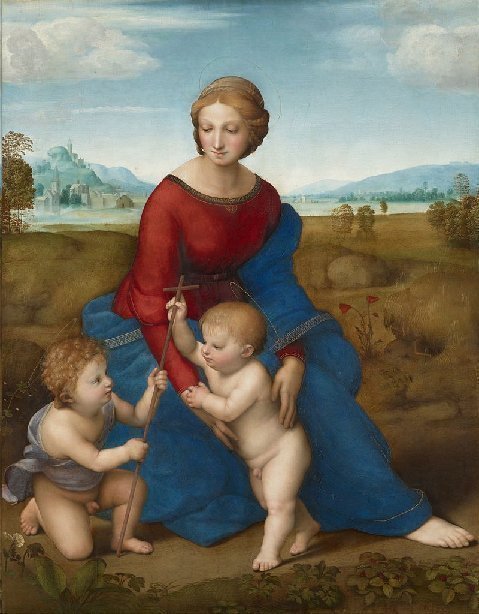
Above: "Madonna with the Christ child and Saint John the Baptist." 1506. Florence School. Kunsthistorisches Museum, Vienna, Austria. 14 May 2016.
This is no Caravaggio.
The Madonna looks serene, not bored. She's depicted in the traditional and accepted red and blue. And, John the Baptist and the Baby Jesus are certainly not gamins as they look lovingly towards one another.
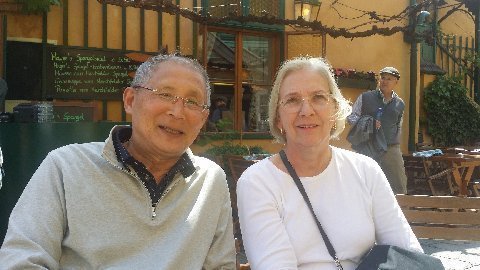
Above: Sam Aono and TIMDT. "Mayer am Pfarrplatz," restaurant. Vienna, Austria. 14 May 2016.
Kind of "its a small world" category...
Though we didn't know one another then, Aono-san was a top official at Japan's Ministry of International Trade and Industry (MITI) when TIMDT and Mwah (sic) were living in Japan, from 1982 to 1985. Then, Mwah (sic) was Business Manager for the Consumer Bank in Tokyo. The Archbishop, based in Hong Kong, was my boss.
Aono-san, his wife Kathy, TIMDT and Mwah (sic) are now cruise mates on a Tauck Tours river cruise, which started a few days ago in Regensberg, Germany and ends in Vienna, Austria, where we are now. The Aonos are retired and living in Seattle, WA.
Aono-san faced off against Laura Tyson and Larry Summers during his MITI years, late 80's to early '90's. He's a graduate of Keio University and has masters degree from MIT.
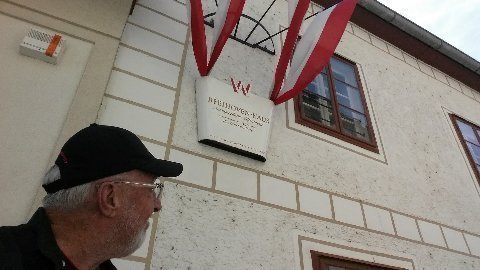
Above: The Bishop contemplates Beethovenhaus, Pfarrplatz 2, Vienna, Austria.
Beethoven composed his sixth (Pastorale) and ninth symphonies at this location.
Memorable was TIMDT's and Mwah's (sic) attendance at a concert in Tokyo in 1984 where the Berlin Philharmonic, led by Herbert Von Karahan, played Beethoven's Ninth. The symphony hall was full of young people giving hope that, at least in Japan, western classical music would survive for at least another generation. Orchestras in the United States have a hard time making ends meet, even with donor subsidies.
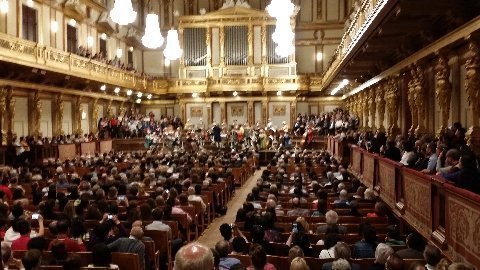
Above: Concert hall, Musikverein. Vienna, Austria. 14 May 2016.
Playing, Wiener Mozart Orchester.
Montage, SpaGo, TIMDT, and Mwah (sic) attended this concert.
The concert was orientated "towards the masses" and this is not necessarily a bad thing. The orchestra played recognizable selections from various Mozart concertos, symphonies and operas. Opera singers came on stage for the operatic numbers. It would have been nice for them to hand out a program.... they didn't.
The singers and musicians were dressed in period costumes. There was only one female in the orchestra, and she was the concert violinist.
Applause was welcomed after each musical excerpt.
The music quality was excellent and the "packed in" crowd made up of tourists and local music aficionados was very enthusiastic.
It was a special experience listening to Mozart music in an ornate concert hall in Mozart's home town.
Addendum
Good morning, hope you and Margaret are having a wonderful ride down the river, this morning good LA Times article on Salt Lake City the renaming of the street-Harvey Milk Blvd-there are wonderful museums with local art do you have the time to visit. Maybe if you're in the mood I would contemplate another trip to Europe give me time to visit sites that we missed on the fastback. Just a thought while you're on the river.
Mr. Z3
Ojai, CA
Looking forward to this tour.
Comic Mom,
New York City, NY
I love your observations, especially the political ones!
Have a great trip.
Rocky,
Miami, FL
zzzzzzzzzzzzzzzzzzzzzzzzzzzzzzzz
Jack Aroon,
Mahwah, NJ

Above: Chapel. Schottenstift Monastery. Vienna Woods, Austria. 15 May 2016.
Here Mass is going on attended by local adherents.
The chanting and the organ give rise to a reverent, ethereal, atmosphere.
I broke off from our tour group to, seated at the rear of the chapel from where this image is taken, attend this Mass for the entire 30 minute period of our stop at the monastery.
The monastery and church date back to the 12th century when Henry II of Austria brought Irish monks to Vienna. The monks did not come directly from Ireland, but came instead from Scots Monastery in Regensburg, Germany. Since 1625, the abbey has been a member of the Austrian Congregation, now within the Benedictine Confederation.

Above: Organist at Schottenstift Monastery chapel. Vienna Woods, Austria. 15 May 2016.
I took this image while listening to a postlude fugue.
The organ and the high arched stone interior cooperate to create a special musical experience. This music correlates to hope, aspiration, and faith.
All music correlates to something along the spectrum of human emotion.
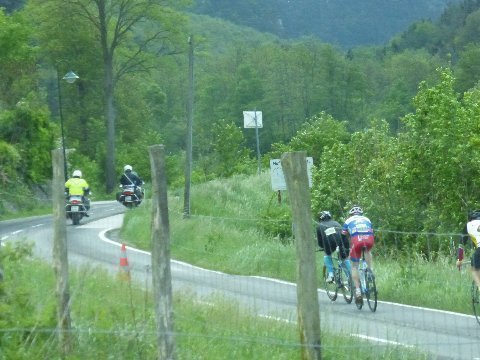
Above: Bicycle Race. Vienna Woods, Austria. 15 May 2016.
Our tour bus was waylaid by this race. We took a detour that added thirty minutes to our planned journey to Baden.

Above: TIMDT in Baden, Austria. 15 May 2016.
No time to take the waters...
Spirit of Sisi permeates... Bilderbergs too.
Tour guide rails against the rise of the Austrian right as she points out putative right wing, uniformed students from private Catholic schools milling around the city. She compares the students to "brown shirts."
Wait.!!!. Brown shirts persecuted Catholics, Jews, Roma, homosexuals.
It is true, that not just within Austria, but throughout Europe, nationalistic feelings are growing. Many people are conflicted between the need for immigration to keep their economies robust - Europeans no longer have children at rates to replace their population - and fear that immigrants will not/cannot be assimilated into their cultures... with all the potential problems that may entail. Cologne... New Years Eve.... 2016?
Notwithstanding, rise of nationalistic, culture championing sentiments should not be conflated with "brown shirts." Guide was out of line in making her caustic assertions about the Catholic students.
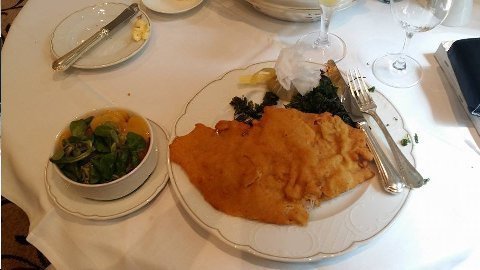
Above: Wienerschnitzel. The Brasserie. Grand Hotel. Vienna, Austria. 15 May 2016.
Ven (sic) in Wien, eat what the Viennese eat?
Adolf (Park City), eat your heart out!
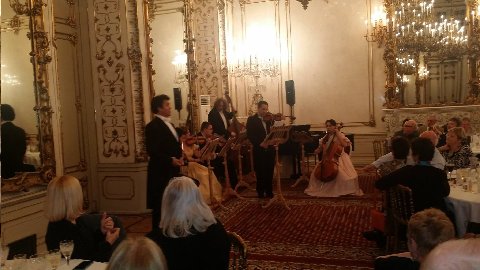
Above: Septet plays Mozart, Beethoven and Strauss. Palais Palavicini, Vienna, Austria. 15 May 2016.
Performance took place at the final dinner for Tauk river boat cruise goers.
I must say, Tauck goes all out. The night was splendid. And, we listened to classic favorites in the same room where Mozart and Salieri would engage in violin duels two hundred thirty some odd years ago. "Amadeus?"
Everything from the food, the musicians, the singers to the waiters was on a thoroughly professional level. Interesting concept! Austrians doing the jobs that Austrians won't do?
It is rare to see professional wait staff any more... so the service quality in and of itself would have been worth the visit.
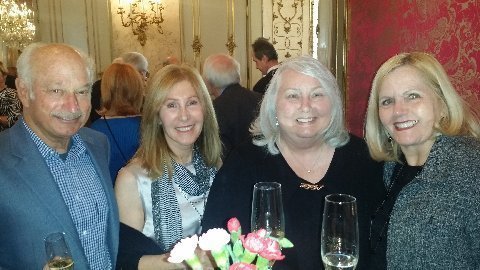
Above: Montage, SpaGo, Bea, and Betty (Golden Girls). Palais Palavincini. Vienna, Austria. 15 May 2016.
Addendum:
Hi,
What a fabulous trip! Unfortunately, the pictures did not come through.
Thx, Sandy,
Seattle, WA
Facebook may be more reliable. Become a friend?
Not correct Steve; in the 1700s part of evolution some people were 3 footed -:)
Mr. Z3
Ojai, CA
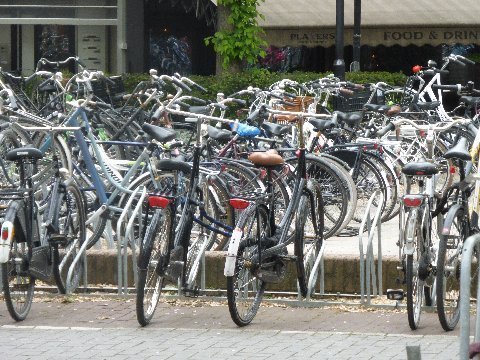
Above: Bike parking lot. Amsterdam, Holland. 16 May 2016.
Montage and Mwah (sic) flew into Amsterdam from Vienna this AM to stay a couple of nights.
TIMDT and SpaGo flew London where they would join cronies for museum hopping and shopping in London for three days, followed by four or five days of Cotswold walking.
Amsterdam reminds me of Copenhagen where bicycling used as transport proliferated.
Nobody wears helmets here, though.
A couple of times I have found myself experiencing near misses with swiftly moving bicycles. I'm slow to get used to the fact that some of the narrow "walking paths" are actually bicycle right of ways. One woman cursed me out in a near miss while walking back to the hotel from De Mollen last night.
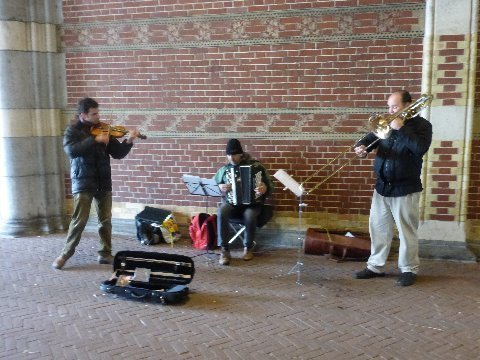
Above: Street musicians. Amsterdam, Holland. 16 May 2016.
An odd, but effective, combination. Violin, accordion and bass trombone.
Professionals moonlighting? They played classical selections beautifully.
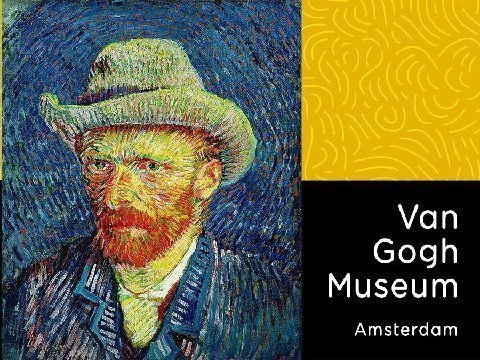
Above: Van Gogh. Van Gogh Museum. Amsterdam, Holland. 16 May 2016.
Museum houses the family collection... most of Van Gogh's works.
Reading about the artistic conflict between Gaugin and Van Gogh, I thought about how Glen Frey and Don Henley never got along, despite creating, together, iconic music.
During Dutchman Van Gogh's early years in Holland, he painted peasant scenes. Did he acquire that taste from early Dutch master Vermeer, who also painted numerous peasant works.... as seen in Kunsthistorisches Museum in Vienna a couple of days ago?
Van Gogh's work reminded me of Munch. TIMDT and Mwah (sic) toured the Munch Museum in Oslo four or five years ago. I Googled "Van Gogh/Munch" and found this from the Fine Art Connoisseur website:
For many, the visionary, psychologically fascinating painters Edvard Munch (1863-1944) and Vincent van Gogh (1853-1890) form a dream pairing. Their works bear a strong visual correlation, carried by the intensity of each artist's vision. Of van Gogh Munch famously wrote "Fire and ardor were in his brush during the few years that he consumed himself for his art." The connection even makes sense historically -- both artists visited Paris in the latter part of the 19th century and benefited from its vibrant artistic culture -- but no record exists to show they actually met. Until now, it has even been extremely rare that they shared gallery space.
http://www.fineartconnoisseur.com/Van-Gogh-Meets-Munch/21511349
My sense of the similarity of Van Gogh's and Munch's work was not misplaced!
Mom had hung a copy of Van Gogh's "Sunflowers" in the 5th East house in Provo during my pre-teen and teen years. I was the son of an educator and a house wife. We couldn't afford a Van Gogh! But, Mom had a sense of what was artistically great and wanted to share that with us kids. Visiting these European museums in later life and finding the contents fascinating derives in no small part from Mom's efforts to acculturate her kids.
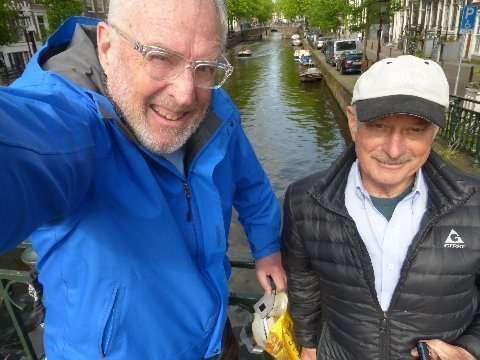
Above: The Bishop and Montage and canal. Amsterdam, Holland. 16 May 2016.
Amsterdam was Montage's idea. We needed to do something post Tauck Danube river trip, he said. It was a good idea. TIMDT and Mwah (sic) were in Amsterdam in the late '70's, but I didn't recall much about the visit.
We arrived at hotel in sunny, cool weather, about noon. We walked a lot... ate cheese and baguette at a canal cafe ... toured the Van Gogh Museum... lazed at a busy sidewalk cafe and watched "tout Amsterdam,"... dined on lamb at Restaurant d'Vjiff Vieghen (Five Flys).... furtively, cap brims pulled down, walked through De Mollen... and had a post dinner cocktail at our hotel, Andaz.
"Five Flys" was pricey. Expensive wine list. Food, served in restored 17th century building, was not bad. Both Montage and Mwah (sic) had lamb. I wouldn't go back. Service was iffy as one reasonably capable female server was stretched between too many tables. The restaurant seems to have adapted to a majority tourist clientele that is less likely to demand the service level that would be demanded by local repeat customers.
Andaz Hotel is a 5 star boutique hotel in the Hyatt family.
Room: Not your typical hotel room configuration. Shower is behind what, at first, looks like a closet. Sink is in a dressing table center stand next to the bed. Commode is in a private closet away from the shower. There are plates on the shelves (full of relevant to Holland books) that look like they're about to fall off, but, they are glued on and serve as useful places to deposit change, keys etc. Room is very "device friendly" with multiple, easily accessible sockets near bed and desk. King size bed is firm... comfortable. The room is bright and very functional. My 1st floor room looks out onto a beautiful courtyard garden. Other rooms, on seven stories, are canal facing.
Hotel: Five Star Andaz Amsterdam is located on Prinsengracht Canal. Bar, and restaurant, and check in areas are very contemporary in design. Black walls, eclectic sculpture, chandeliers asymmetrically placed, lots of indirect lighting around the mirrored, black, marble bar and black walled lobby after dark. It is nice here. Kind of arty.
Check in, though, was inept and tedious. Unbelievably, a hotel manager commandeered the computer being used by our check-in clerk to handle something she wanted to do for someone else. When questioned about the interruption, the manager did not apologize. Rather, she said our clerk had access to another computer. She (the manager) should be fired. She was not at all oriented towards good customer service. Check-in process took over 30 minutes.
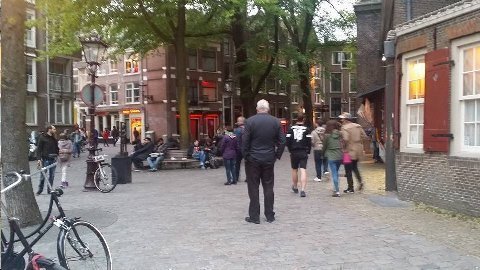
Above: Bishop. De Mollen. Amsterdam, 16 May 2016.
Perplexed by proliferation of red light illuminated vitrines, the Bishop returns to the hotel without solving the mystery.
Addendum:
Steve:
If you're still in Nuremburg, go to the Brathaus in the old city. Outstanding.
Bling,
Albuquerque, NM
zzzzzzzzzzzzzzzzzzzzz
Jack Aroon,
Mahwah, NJ
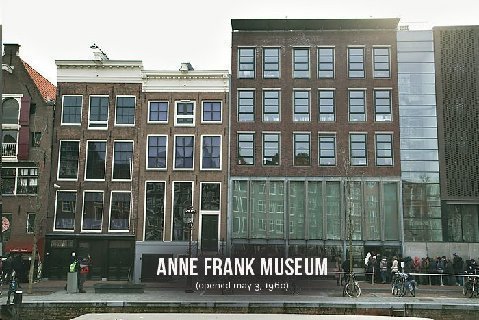
Above: Anne Frank Museum. Prinsengracht 263-267, Amsterdam, Netherlands. 17 May 2016 (file image).
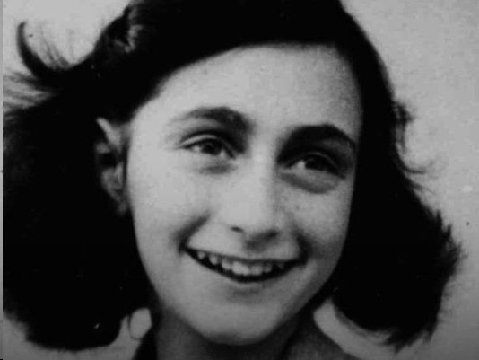
Above: Anne Frank. File image from May 1942. Amsterdam, Netherlands.
Were Anne Frank to have survived, she would be 85 years old, today. She died of typhus at Bergen-Belsen concentration camp in 1945.
Montage and I visited this site today, 17 May 2016. It is sobering - and disturbing - to imagine that 72 years ago, walking the street where we find ourselves today, were Nazi troops rounding up Jewish people to send them to death camps.
The museum building seen in the image is an enclosure... not the façade of the building owned by Otto Frank, Anne Frank's father. The enclosure surrounds the original innards of the Amsterdam three story walk-up, including the back annex, where Anne Frank, her parents, sister and four others, spent two years in hiding from the Nazis.
Montage and I, along with a bevy of other tourists who had pre-booked 11 AM tickets, were able to walk throughout the rooms where Anne, her family and friends cowered in silence, fearful daily of capture, for two long years. The stress that this must have caused the hiders and their abettors can hardly be imagined.
Post occupation of Amsterdam from 1939 the Nazis began to systematically make life more difficult for resident Jews. It started with Jews being required to wear yellow stars on their clothing. it escalated to forbidding Jews to use public transportation and limiting their shopping hours. By 1942 it "ended" with Jewish people being rounded up for shipment to Nazi death camps.
Anne, thirteen to fifteen years old during the period of her hiding with her family, wrote a diary about her experience, before, in 1944, she and her family were "outed" by an informer and transported to various of the Nazi concentration camps. Here diary was found strewn on the floor of the annex by Christian employees of father Otto Frank's business and given to Otto Frank after the war. Original pages of the diary, in Anne's handwriting, can be seen in the museum.
Anne Frank's diary, first published in the 1950's by her father, the only one of the eight to survive the war, was entitled, "The Diary of a Young Girl." To date, the book is one of the most widely read books in the world and has sold 35 million copies.
I'm half way through reading "Diary of a Young Girl" for the first time. Hearing Anne's descriptions of the Secret Annex and reading about the stressed interactions of the hiders and their abettors was made all the more poignant for me as I walked through the Secret Annex today.
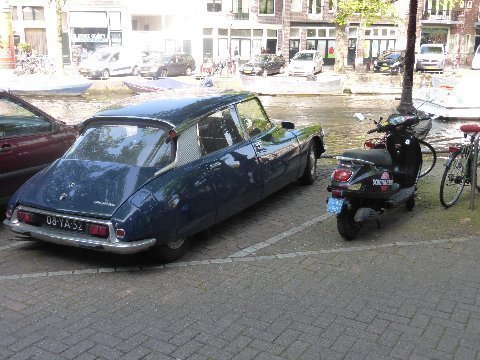
Above: Circa 1965 Citroen DS 21. Amsterdam, Netherlands. 17 May 2016.
As Assistant to the President of the LDS Mission in Paris, France the final half of 1967, I frequently, driving a DS 21, similar to the car pictured above, chauffeured the LSD Mission President, H. Duane Anderson and his wife Leola to various parts of the mission in the Paris area and throughout western France.
Mitt Romney became Assistant to the President a year or so after I departed the mission in January 1968. While chauffeuring President and Sister Anderson in the same "mission car" DS that I had driven, Romney had a collision. Sister Anderson died in the accident.
Romney was flown home to recover from his injuries. He later returned to France to complete his mission. French authorities exonerated Romney from driver culpability, blaming the accident on the driver of the other vehicle involved in the accident.
President Anderson was injured in the accident. He returned to his home in Idaho Falls, ID, United States as soon as he was able.
Note: In hindsight, it seems amazing that we 20-year-olds from the American "provinces" where driving was relatively easy, where most people assiduously attempted follow the rules of the road, were piloting high performance vehicles in the challenging driving environment of France, where many drivers wore gloves and ignored speed limits.
All cars were stick shift. Every day was a rally. Back then, "suicide roads," with a middle lane open to traffic going in either direction, proliferated. Driving in France was a form of playing "Chicken." These days in France, "middle lane" configured highways are rare, but the rally impulse remains.
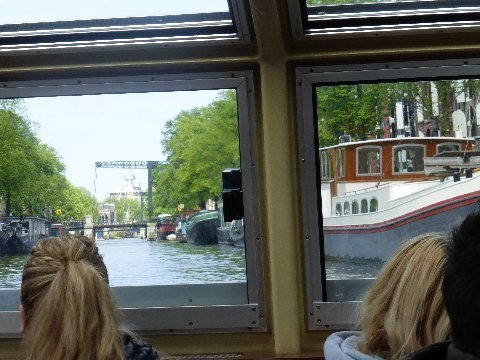
Above: Canal View. Amsterdam, Netherlands. 17 May 2016.
Montage and Mwah (sic) took a circle tour by boat.
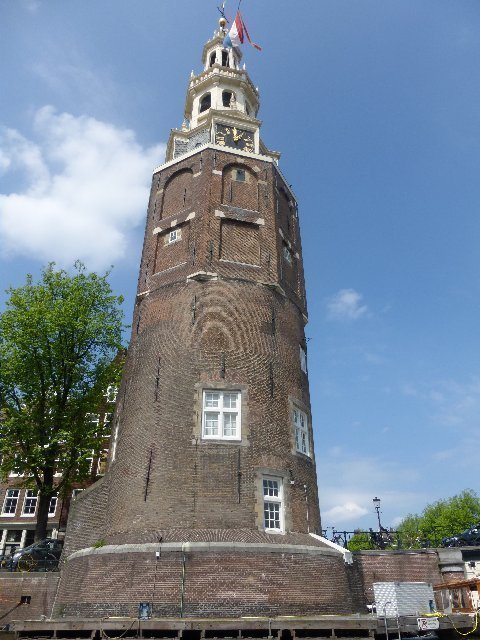
Above: Munttoren. Amsterdam, Holland. 17 May 2016.
The tower was originally part of one of the main gates to Amsterdam's medieval city wall. Built in 1480.
Image is as seen from our canal tour boat.
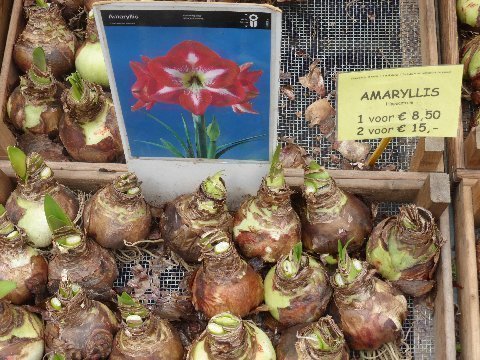
Above: Amaryllis Bulbs. Flower Market. Amsterdam, Netherlands. 17 May 2016.
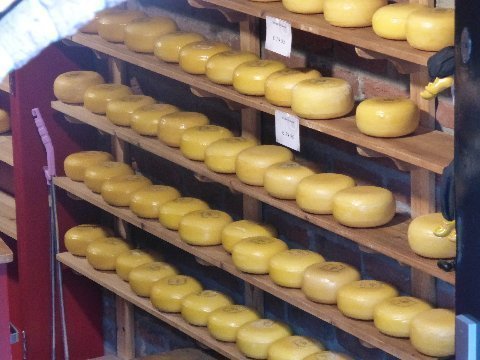
Above: Cheese. Flower Market. Amsterdam, Netherlands. 17 May 2016.
Edam and Gouda are the two big cheeses of Holland. After that, Queen Margrethe.
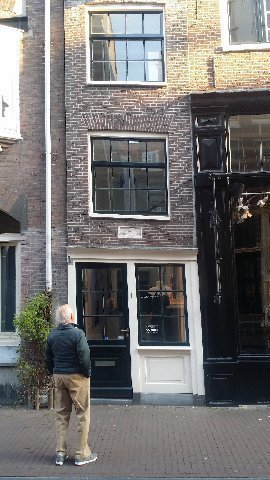
Above: Montage observes asymmetrical building. Amsterdam, Holland. 17 May 2016.
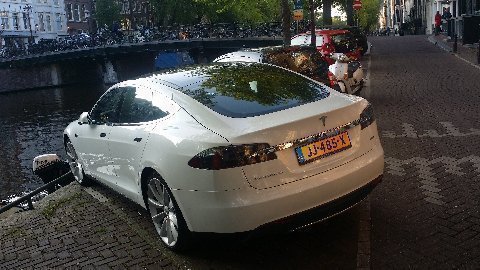
Above: Tesla. Prinsengracht. Amsterdam, Holland. 17 May 2016.
Plenty of Teslas near our hotel on Prinsengracht.
Montage and Mwah (sic) were surprised when arriving at Schipol Airport cabstand yesterday. There was a long line of Teslas, one of which we took into the city to our hotel.
Smooth ride! But, rear seat a bit restrictive... especially for a big person.
Our Tesla cab driver noted that the local government was quick to issue taxi licenses to electric cars and to temporize on license issuance for gas powered cars.
The taxi driver said Tesla had recently opened an assembly plant in The Netherlands. There are three Tesla dealers in Amsterdam. Later on we noticed Tesla's parked charging stations at various locations throughout the inner city.
Earlier today, while waiting for Montage to see a man about a dog, and while seated at a cafe table, I read an article where Bob Lutz was interviewed and asked about Tesla.
Car guy Lutz said...
The last car at GM I was responsible for was the Volt... and, its one of my few fails. It has different electric motor technology than Tesla's S model, which is much better.
I love the S. it deserves to be successful.
The X is going to have some problems. Doors don't work well. Frame too weak.
The new, smaller Tesla coming out has production delays... people are pre buying it... but, it remains to be seen if its going to come out any time soon. Production delays are expected.
Apropos production delays, I read another article later in the day stating that Musk's constant missing of deadlines is driving Wall Street crazy. Because, in missing deadlines, Musk also scores successes. Musk replies that he is engaged in transformational endeavors and as such, to motivate his people, he needs to set deadlines, many of which he knows, at the outset, won't be reached.
Musk has the kind of vision that will be necessary to save the human race... that is, he sees the need for mankind to hedge its survival bets by colonizing another planet. Musk (45 something) has said he'd like to live out his retirement years on Mars. He appears to be moving successfully towards his goal. SpaceX recently scored its second successful landing, on a barge, of a space delivery vehicle.
In November 2015, I was present when Musk was guest speaker at a private equity fund limited partners meeting to which I was invited (thru the fund, I am a SpaceX investor). I obtained the mike during Q and A and asked Musk if he'd read "The Martian" or seen the movie. He said he loved the book and the movie both. Each, he said, serve to get people excited about and interested in space travel. And, that, he said, is a good thing.
For one reason or another, earth will be come uninhabitable in time. Imminent - at least in geologic time frame - are the blowing up of the Yellowstone Caldera, the slippage of the Pacific Plate near Seattle, and the probability of a species destroying comet hitting the earth, as occurred in Yucatan, 70 million years ago... all of these potential disasters can eliminate life on earth as we know it.
Physicist Stephen Hawking is also an advocate of extra terrestrial exploration and colonization.
Addendum:
When visiting the Van Gogh museum in 1978, I was awestruck by the vivid blobs of thick color on each painting. It was then I realized that any copy of a work of art is a poor substitute for seeing the real thing. If you love art, or a particular artist, it is worth the effort to see the original!
Your trip sounds so enjoyable. Thanks, as always, for sharing it with all of us armchair travelers.
Your cuz,
Sara
Palo Alto, CA
zzzzzzzzzzzzzzzzz
Jack Aroon,
Mahwah, NJ
Hi Steve, Hope your flight was great. I'm sorry, but none of these pictures will open. Would love to see them. Thanks for thinking of me.
Bea,
Livermore, CA
Many, especially the younger, don’t love you in Amsterdam. Still some good Indonesian food there.
the monk,
Salina, UT
When I lived in the Netherlands, one of the first things I was told was that if I hit a biker or a pedestrian with my car (a mini, mini van called a Toyota Picnic) - it was my fault - no matter what And could lead to deportation. Ahhhh the Van Gogh Museum! The Dutch mostly just don't get customer service in their egalitarian, semi socialist system. They don't even like to be thanked.
Kristen,
Park City, UT
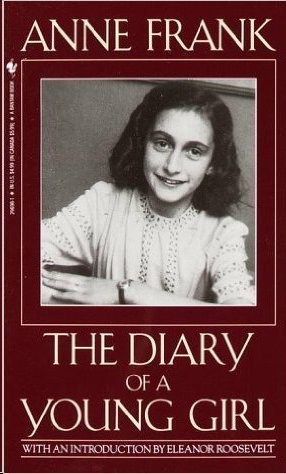
Above: Cover, "The Diary of a Young Girl." Anne Frank. 18 May 2016
I completed this book today... complementing my visit, yesterday, to the Anne Frank Museum, Prinsengracht 263-267, Amsterdam, Netherlands. Most of my reading time was on the airplane as I returned from Amsterdam to Salt Lake City.
Anne Frank was aged thirteen to fifteen when she wrote her diary... 1st entry, 12 June 1942 and final entry, 01 August 1944. Anne Frank died in Bergen-Belsen concentration camp in 1945 shortly before the war's end.
Takeaways...
Anne Frank's diary entries show remarkable depth of insight into human character, particularly coming from an early teen. One of many examples: She describes fellow hider Dussel's selfish acts. But, she doesn't leave it there. She also draws philosophical conclusions about Dussel: "Anyone who is so petty and pedantic at the age of fifty-four was born that way and is never going to change." Such "philosophical insights" on the character of her fellow hiders pervade the book.
In her writing, Anne Frank showed a highly developed self awareness and ability to describe same.
The Anne Frank who enjoyed that heavenly existence (referring to her idlyic pre hiding life as a "tween) was completely different from the one who has grown wise within these walls....
... you're probably wondering how I could have charmed all those people. Peter says it's because I'm "attractive', but that isn't it entirely. The teachers were amused and entertained by my clever answers, my witty remarks, my smiling face and my critical mind. That's all I was: a terrible flirt, coquettish and amusing. I had a few plus points, which kept me in everybody's good graces: I was hardworking, honest and generous. I would never have refused anyone who wanted to peek at my answers. I was magnanimous with my sweets and I wasn't stuck up.
Would all that admiration eventually have made me over-confident? It's a good thing that, at the height of my glory, I was suddenly plunged into reality. It took me more than a year to get used to doing without admiration.
I wondered as I read if Anne's diary, if her discipline to write every day enhanced her ability to draw insights usually only expected from well educated adults. Did being forced to stay, surreptitiously, in a very small space, accelerate her intellectual development and capacity for deep reflection?
In contrast to the insight and depth shown in the diary was also teen immaturity and coquettishness. In her writing she was very cruel to her mother. Her relationship with Peter van Damm, the son of a couple also hiding with the Frank's morphed from contempt to infatuation. Her lack of reluctance to hold back her infatuation with Peter was very much the stuff of a teen girl's diary.
The hiders have a radio... they are aware of the progress of the war. Non-Jewish employees of Frank's firm help them acquire food and supplies. Hearing of the progress of the war... or not.. causes Anne's writing tone to move between hope and despair as the war unfolds. Anne's up one day... down the next. Anne's emotional swings force the reader to better appreciate the pressures and tensions of hiding from the Nazis.
Two years is a long time for eight people to hide in a small annex of an Amsterdam walk-up. Well into the hiding period, the parties were fixing their own food and not talking to one another during meals. That the ruse lasted as long as it did - 2 years - before the hiders were betrayed seems remarkable.
It was good to read the book immediately after having walked through the annex, now converted to a museum. Walking through the annex and reading Anne Frank's diary almost contiguously created for me a poignant awareness of evil and its ongoing threat to human liberty. Such "poignant awareness" needs to be refreshed from time to time.... lest we forget.
Addendum:
Do visit the Rijksmuseum too - wonderful masterpieces.
Enjoy.
Eton Mum
Richmond on Thames